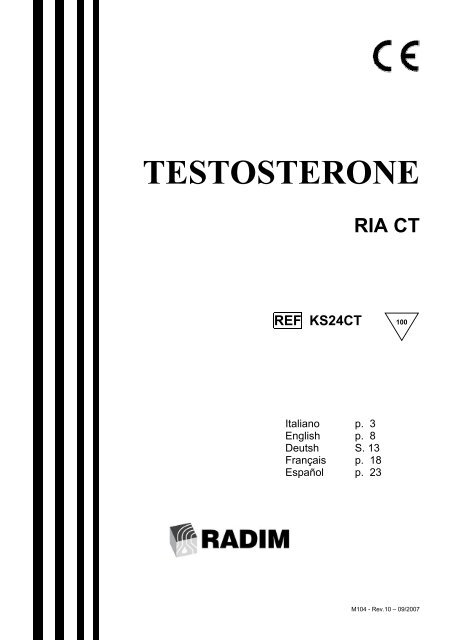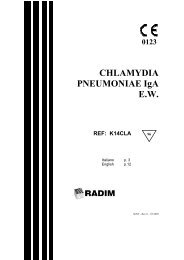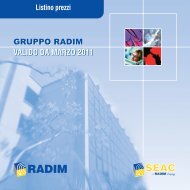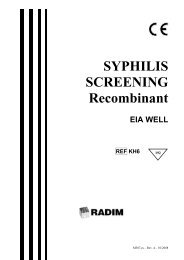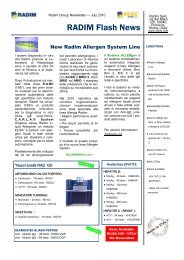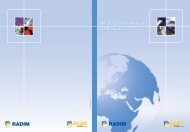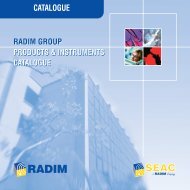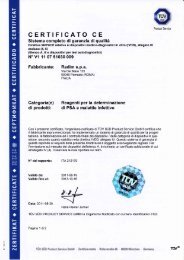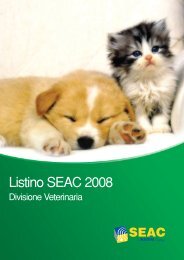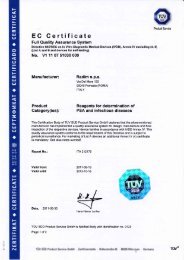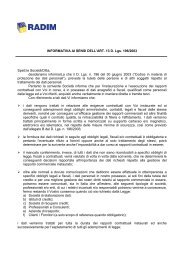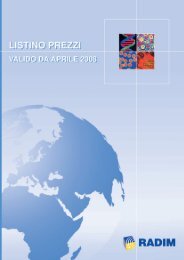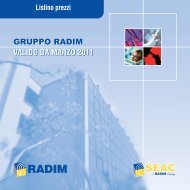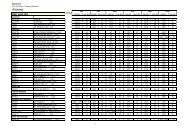testosterone ria ct ref ks24ct - Radim S.p.A.
testosterone ria ct ref ks24ct - Radim S.p.A.
testosterone ria ct ref ks24ct - Radim S.p.A.
Create successful ePaper yourself
Turn your PDF publications into a flip-book with our unique Google optimized e-Paper software.
TESTOSTERONE<br />
REF KS24CT<br />
Italiano p. 3<br />
English p. 8<br />
Deutsh S. 13<br />
Français p. 18<br />
Español p. 23<br />
RIA CT<br />
100<br />
M104 - Rev.10 – 09/2007
Reagenti del Kit - Kit Reagents - Kit Reagenzien - Rea<strong>ct</strong>ifs de la Trousse - Rea<strong>ct</strong>ivos del<br />
Kit.<br />
Reag, Reac Quant, Cant Stato fisico, Physical state, Aggregatzustand,<br />
État physique, Estado fisico.<br />
CT<br />
100<br />
(4 x 25)<br />
Pronte per l'uso, Ready for use,<br />
Gebrauchsfertig, Prêt à l'emploi, Listo para el<br />
uso.<br />
CAL<br />
1 x 2 mL<br />
5 x 1.5 mL<br />
Pronti per l'uso, Ready for use,<br />
Gebrauchsfertig, Prêt à l'emploi, Listo para el<br />
uso.<br />
CONJ I 125 Pronto per l'uso, Ready for use,<br />
1 x 50 mL Gebrauchsfertig, Prêt à l'emploi, Listo para el<br />
uso.<br />
CTR<br />
1 x 2 mL Liof, Lyoph<br />
"Le Istruzioni per l'uso tradotte nelle altre lingue di interesse sono consultabili sul sito Internet all'indirizzo<br />
www.radim.com".<br />
“The instru<strong>ct</strong>ions for use available in the other languages of interest can be viewed on our website<br />
www.radim.com".<br />
“Οι οδηγίες χρήσης μεταφρασμένες στις άλλες ενδιαφερόμενες γλώσσες όπως επίσης στην ηλεκτρονική<br />
διεύθυνση www.radim.com".<br />
“In den anderen Sprachen von Interesse ist die Bedienungsanleitung kann auf der Website unter der<br />
Adresse www.radim.com konsultiertwerden”.<br />
"Le mode d’emploi dans les autres langues intéressées est consultable sur le site Internet à l'adresse<br />
www.radim.com”.<br />
“Las instrucciones de uso traducidas en los otros idiomas de interés se pueden consultar en nuestro<br />
sitio Internet www.radim.com”.<br />
"As instruções de uso traduzidas nos outros idiomas de interesse podem ser consultadas no nosso site<br />
Internet, ao endereço www.radim.com"<br />
KS24CT TESTOSTERONE RIA CT<br />
M104 - Rev.10 – 09/2007 - Pag. 2/32
DOSAGGIO RADIOIMMUNOLOGICO PER LA DETERMINAZIONE QUANTITATIVA DEL<br />
TESTOSTERONE NEL SIERO UMANO<br />
PER USO DIAGNOSTICO IN VITRO<br />
APPLICAZIONI CLINICHE<br />
Il Testosterone è uno steroide androgeno a 19 atomi di carbonio di peso molecolare 288.4. E'<br />
sintetizzato dalla zona interstiziale del testicolo, precisamente dalle cellule di Leydig a partire da Δ5-<br />
Pregnenolone e dal Progesterone seguendo le due vie biosintetiche Δ4 e Δ5. A livello testicolare sembra<br />
essere p<strong>ref</strong>erita la via Δ5. Una piccola parte è prodotta dalla zona reticolare del corticosurrene ed ha<br />
come precursori il Δ4-Androstenedione ed il DEA. Nel sangue l'ormone è veicolato da una betaglobulina.<br />
Circa il 97- 99 % del Testosterone circolante è legato alla proteina vettrice; il rimanente, libero, è<br />
considerato metabolicamente attivo. E' escreto come glucuronato oppure trasformato in Δ4-<br />
Androstenedione che subisce ulteriori processi metabolici. I suoi principali cataboliti sono l'Androsterone,<br />
l'Etiocolanolone e l'Epiandrosterone. Può inoltre trasformarsi in Epi<strong>testosterone</strong>, importante catabolita<br />
agente sull'ipotalamo ed in Diidro<strong>testosterone</strong> (DHT) ad opera di una 5-α-reduttasi. Il DHT è più attivo<br />
del Testosterone a livello delle cellule bersaglio.<br />
Il Testosterone determina le caratteristiche modificazioni dei diversi stadi puberali stimolando lo sviluppo<br />
dei caratteri sessuali secondari (voce, statura, apparato pilifero) ed agendo sul pene, scroto, vescicole<br />
seminali e prostata. Aumenta la sintesi proteica, positivizza il bilancio di azoto, fosforo e potassio,<br />
stimola l'epitelio germinativo del follicolo pilifero. Agisce nella differenziazione del comportamento<br />
sessuale e mantiene la normale spermatogenesi.<br />
Esiste inoltre un meccanismo di feedback negativo con le strutture ipotalamo-ipofisarie svolgentesi sulle<br />
gonadotropine FSH e LH. Nell'uomo è importante valutare la concentrazione del Testosterone in caso di:<br />
ipogonadismo, neoplasie testicolari, sindrome di Klinefelter.<br />
Nella donna lo valutiamo in caso di: neoplasie ovariche, ipertricosi, sindrome di Stein-Leventhal.<br />
PRINCIPIO DEL METODO<br />
Il presente metodo analitico consiste in una competizione che si instaura tra antigene marcato<br />
(coniugato radioattivo) ed antigene non marcato (calibratore, campione) a legarsi ad un numero limitato<br />
di siti leganti specifici sull'antisiero adeso alle provette. Dopo l'incubazione il liquido contenuto nelle<br />
provette viene eliminato mediante aspirazione, e le provette contate in un gamma counter.<br />
REAGENTI CONTENUTI NEL KIT: PREPARAZIONE E STABILITA'<br />
− I reagenti sono sufficienti per 100 tubi.<br />
− Il kit deve essere conservato a 2 -8°C.<br />
− La data di scadenza di ciascun reagente é indicata sulla rispettiva etichetta.<br />
CT Provette Sensibilizzate: 100 provette (4x25) sensibilizzate con anticorpo policlonale anti-<br />
Testosterone (coniglio). Le provette non utilizzate devono essere riposte nella loro custodia a 2-8°C,<br />
accuratamente richiusa.<br />
CAL Calibratori: 6 flaconi di Testosterone in matrice sierica: 1 flacone di Zero Calibratore (2 mL) e 5<br />
flaconi (1.5 mL) alle seguenti concentrazioni: 0.25, 0.5, 1.5, 6.0 e 15.0 ng/mL. Pronti per l'uso.<br />
Conversione: 1 ng/mL = 3.467 nmol/L. Conservante: NaN3 (< 0.1%).<br />
N.B.: verificare sempre l'esatta concentrazione sul foglio di C.Q.<br />
CONJ I 125 Coniugato Radioattivo: 1 flacone (50 mL) di Testosterone- 125 I in tampone fosfato e<br />
proteine. Contenuto di radioattività: 77.7 KBq. Pronto per l'uso e colorato in rosso. Conservante: NaN3<br />
(
MATERIALE NECESSARIO MA NON FORNITO<br />
− Provette in plastica monouso (12x75 mm).<br />
− Portaprovette.<br />
− Micropipette automatiche a punte intercambiabili a volume va<strong>ria</strong>bile.<br />
− Vortex.<br />
− Bagno termostatato a 37°C.<br />
− Pompa aspirante oppure apparecchiatura automatica equivalente.<br />
− Contatore gamma a scintillazione.<br />
− Carta logit-log o semilogaritmica.<br />
− H2O distillata.<br />
MATERIALE RADIOATTIVO<br />
Radionuclide presente: I 125<br />
INFORMATIVA (D.Lgs. 230/95 – D.Lgs. 241/00 art. 19) E NORME DI SICUREZZA E PREVENZIONE<br />
Per ottenere risultati corretti e riproducibili, è necessario osservare le seguenti norme:<br />
− Non mescolare reagenti di lotti differenti.<br />
− Non usare i reagenti dopo la data di scadenza.<br />
− Non esporre i reattivi e i campioni a calore intenso o a forti sorgenti di inquinamento.<br />
− Usare vetre<strong>ria</strong> perfettamente pulita ed esente da contaminazioni di ioni metallici o sostanze<br />
ossidanti.<br />
− Usare acqua distillata o deionizzata, conservata in recipienti perfettamente puliti.<br />
− Evitare accuratamente contaminazioni tra campioni; a tal fine è consigliabile usare pipette con<br />
puntali monouso per ogni campione e per ogni reattivo.<br />
− Non modificare in alcun modo il Procedimento Operativo di esecuzione del test. Eventuale non<br />
rispetto di:<br />
• sequenza e quantità nell’aggiunta dei reattivi<br />
• tempi e temperatura di incubazione<br />
può dare luogo a risultati clinici errati.<br />
− Ricostituire gli eventuali reagenti liofili secondo le modalità descritte sulle etichette. Eventuale<br />
utilizzo di reattivi o volumi non idonei, può provocare l’ottenimento di dati clinici non attendibili.<br />
− In caso di procedura manuale è importante l’utilizzo di pipette calibrate e possedere un’adeguata<br />
manualità tecnica. In particolare è essenziale una buona precisione nella preparazione e<br />
dispensazione dei reattivi. E’ necessario un adeguato piano di manutenzione (pulizia e calibrazione)<br />
di tale strumentazione.<br />
− Accertarsi che tutta la strumentazione usata (vetre<strong>ria</strong>, bagno termostatato, agitatore e lavatore,<br />
contatore gamma, frigoriferi usati per la conservazione dei kit e dei campioni) sia perfettamente<br />
funzionante, adeguatamente calibrata e sia soggetta ad un regolare piano di manutenzione. Un<br />
uso non accurato di ognuno di questi strumenti può produrre errori metodologici che possono<br />
condizionare la riproducibilità e l’affidabilità dei risultati ottenuti.<br />
− Utilizzare un adeguato metodo per la corretta identificazione dei campioni. Possibili conseguenze<br />
possono essere sia la perdita di specificità del dispositivo che risultati analitici errati.<br />
Con lo scopo di ridurre i rischi di tipo fisico, biologico e chimico, è necessario osservare le<br />
seguenti norme di sicurezza:<br />
− Utilizzare dispositivi di protezione individuale (es.: guanti monouso, camice, ecc.) durante la<br />
manipolazione di mate<strong>ria</strong>le radioattivo e/o potenzialmente infetto e durante il dosaggio.<br />
− Non pipettare i reagenti con la bocca.<br />
− Non fumare, mangiare, bere o applicare cosmetici durante l'esecuzione del dosaggio.<br />
− La manipolazione di sostanze radioattive deve essere eseguita in aree specificamente predisposte.<br />
− Le sostanze radioattive devono essere conservate nei loro contenitori originali in un’area<br />
specificamente predisposta.<br />
− E’ necessario compilare un registro che indichi dettagliatamente l’ingresso, la conservazione e<br />
l’eliminazione di tutto il mate<strong>ria</strong>le radioattivo ricevuto.<br />
− E’ necessario eliminare immediatamente qualunque contaminazione radioattiva secondo le<br />
procedure stabilite.<br />
KS24CT TESTOSTERONE RIA CT<br />
M104 - Rev.10 – 09/2007 - Pag. 4/32
− I mate<strong>ria</strong>li di origine umana utilizzati nella preparazione del presente kit sono stati saggiati per la<br />
presenza di HBsAg, anti-HIV e anti-HCV e sono risultati ripetutamente negativi. Comunque nessun<br />
test attualmente disponibile garantisce l'assenza degli agenti virali responsabili della sindrome da<br />
immunodeficienza acquisita, dell'epatite B ed epatite C. Tutti i reagenti contenenti mate<strong>ria</strong>le<br />
biologico e tutti i campioni di siero umano devono essere considerati potenzialmente infettivi.<br />
− Evitare la produzione di schizzi e la formazione di aerosol; qualora ciò si verificasse ripulire<br />
accuratamente con ipoclorito di sodio ad una concentrazione del 3%. Il mezzo adoperato per la<br />
pulizia deve essere trattato come residuo potenzialmente infetto ed eliminato secondo le modalità<br />
opportune.<br />
− La sodio azide contenuta come conservante in alcuni reagenti, può reagire con il piombo ed il rame<br />
delle tubature formando azidi di metallo altamente esplosive. Per evitare la formazione e l'accumulo<br />
di tali composti far scorrere abbondante acqua sui reagenti eliminati.<br />
− Ai sensi del D.L. italiano n. 22 del 05.02.97, che fa riferimento alle direttive CEE (91/156/CEE,<br />
91/689/CEE, 94/62/CEE) tutti i rifiuti provenienti da lavorazioni manuali e/o in automatico sono<br />
classificati rifiuti speciali pericolosi con codice di classificazione CER 180103 (rifiuti infetti o<br />
potenzialmente infetti); devono quindi essere eliminati affidandoli a ditte autorizzate al ritiro ed allo<br />
smaltimento.<br />
− Tutti i rifiuti provenienti da lavorazioni con radioisotopi devono essere smaltiti affidandoli a ditte<br />
autorizzate al ritiro in accordo a quanto previsto nel D.Lgs. 241/2000.<br />
− L'acquisto, la detenzione, l'impiego e lo smaltimento di mate<strong>ria</strong>le radioattivo (sia solido che liquido)<br />
sono soggetti alle disposizioni locali previste dalle autorità legislative.<br />
� La quantità di radioattività alla data di riferimento è specificata nell’etichetta esterna del kit.<br />
RACCOLTA E PREPARAZIONE DEI CAMPIONI<br />
Il dosaggio può essere effettuato su siero. I campioni fortemente lipemici od emolizzati devono essere<br />
scartati. I campioni possono essere conservati a 2 -8°C per 1-2 giorni; per periodi più lunghi conservarli<br />
a -20°C. Assicurarsi pertanto che i campioni siano perfettamente limpidi prima di dosarli. Si consiglia di<br />
non congelare e scongelare ripetutamente i campioni.<br />
PROCEDIMENTO OPERATIVO<br />
− Attendere che i reagenti ed i campioni raggiungano la temperatura ambiente.<br />
− Agitare i campioni per inversione prima dell'uso.<br />
1 - Preparare le provette non sensibilizzate per l'Attività Totale (T) e per il Legame aspecifico (NSB) e<br />
provette sensibilizzate per Zero Calibratore (Bo), Calibratori (1-5), Siero di Controllo e Campioni.<br />
2 - Dispensare 100 µl di ciascun Calibratore, del Siero di Controllo e dei Campioni nelle rispettive<br />
provette.<br />
3 - Dispensare nelle provette del legame aspecifico (NSB) 100 µl del Calibratore a concentrazione<br />
zero.<br />
4 - Dispensare 500 µl di Coniugato Radioattivo in tutte le provette.<br />
5 - Agitare su vortex.<br />
6 - Incubare per 60 minuti a 37°C.<br />
7 - Aspirare accuratamente la miscela d'incubazione da tutte le provette, eccetto quelle dell'attività<br />
totale, mediante pompa aspirante oppure decantare asciugando il bordo delle provette su carta<br />
bibula.<br />
8 - Misurare la radioattività presente nelle provette in un contatore gamma per 1 minuto. Si<br />
raccomanda di controllare il fondo dello strumento prima di effettuare il conteggio. Per non va<strong>ria</strong>re<br />
la sensibilità del sistema é necessario che il fondo sia ridotto al minimo oppure opportunamente<br />
corretto.<br />
SCHEMA DEL DOSAGGIO: vedi p. 31<br />
CALCOLO DEI RISULTATI<br />
Cpm Bo - Cpm NSB<br />
Capacità legante % = --------------------------- x 100<br />
Cpm T - Cpm NSB<br />
KS24CT TESTOSTERONE RIA CT<br />
M104 - Rev.10 – 09/2007 - Pag. 5/32
Percentuale di legame per i Calibratori, Controlli, Campioni =<br />
B Cpm Calibratori o Campioni - Cpm NSB<br />
----- % = ---------------------------------------------------- x 100<br />
Bo Cpm Bo - Cpm NSB<br />
Tracciare la curva di taratura su carta logit-log o semi-log, ponendo sull'asse delle ascisse le dosi dei<br />
calibratori e su quello delle ordinate il rapporto B/Bo % relativo ad ogni dose dei calibratori. Calcolare le<br />
percentuali relative ad ogni campione ed interpolarle sulla curva di taratura per ottenere la<br />
concentrazione di Testosterone presente nei campioni in esame, espressa in ng/mL.<br />
ESEMPIO DI CALCOLO<br />
I valori sotto riportati devono essere considerati unicamente un esempio e non devono essere utilizzati<br />
in luogo dei dati sperimentali.<br />
Descrizione cpm B/Bo% B/T % Testosterone<br />
Attività Totale (T) 38475<br />
Legame Aspecifico (NSB) 160 0.41<br />
Calibratore 0.0 ng/mL 15788 41.2<br />
Calibratore 0.25 ng/mL 12734 80.6<br />
Calibratore 0.5 ng/mL 11367 71.9<br />
Calibratore 1.5 ng/mL 8729 55.2<br />
Calibratore 6.0 ng/mL 4924 30.5<br />
Calibratore 15.0 ng/mL 3061 19.3<br />
Campione 9788 62.0 1.0 ng/mL<br />
VALORI NORMALI<br />
I valori riportati nella tabella seguente sono soltanto indicativi. Si raccomanda a ciascun laboratorio di<br />
stabilire i propri intervalli di riferimento.<br />
Donna 0.1 - 1.0 ng/mL<br />
Uomo 2.5 - 8.5 ng/mL<br />
Bambino 0.0 - 0.3 ng/mL<br />
Conversione: 1 ng/mL = 3.467 nmol/L.<br />
CRITERI DI ACCETTAZIONE<br />
Prima di procedere al calcolo dei risultati, verificare che la concentrazione del siero di controllo rientri nel<br />
range di accettazione descritto nel Foglio di Controllo Qualità.<br />
CARATTERISTICHE METODOLOGICHE<br />
SPECIFICITÀ<br />
Il presente metodo analitico ha mostrato le seguenti reazioni crociate: 100% con Testosterone, 5.6% con<br />
5-α-Diidro<strong>testosterone</strong>, 3.8% con 1,(5α)-Androsten-17-β-ol-3one, 2.6% con 19-Idrossi-Androstenedione,<br />
1.6% con Androstenedione e inferiore allo 0.1% con Androstenediolo, SHBG, Danazolo, Estrone, DHEA-<br />
S, Estradiolo, 5-α-Androstan-3α-ol-17one e 5-β-Androstan-17 α -ol 3one.<br />
La percentuale di interferenza é calcolata utilizzando la formula di Abraham : X/Y x 100 dove X e Y sono<br />
rispettivamente il peso della sostanza da dosare ed il peso della sostanza interferente tali da ridurre la<br />
capacità legante del 50 %.<br />
SENSIBILITÀ<br />
La sensibilità é la dose più bassa di Testosterone in grado di abbassare del 5% la capacità legante<br />
iniziale. Tale dose é risultata pari a 0.017 ng/mL.<br />
PRECISIONE<br />
La precisione é stata valutata misurando la va<strong>ria</strong>bilità intra-saggio ed inter-saggio su 3 sieri a differenti<br />
concentrazioni di Testosterone.<br />
Intra-saggio (Ripetibilità)<br />
KS24CT TESTOSTERONE RIA CT<br />
M104 - Rev.10 – 09/2007 - Pag. 6/32
Siero Media ± D.S. C.V. Replicati<br />
(ng/mL) % n.<br />
a 0.53 ± 0.0327 6.1 10<br />
b 0.91 ± 0.0356 3.9 10<br />
c 4.45 ± 0.0685 1.5 10<br />
Inter-saggio (Riproducibilità)<br />
Siero Media ± D.S. C.V. Dosaggi<br />
(ng/mL) % n.<br />
a 0.425 ± 0.04 9.3 10<br />
b 1.65 ± 0.15 9.0 10<br />
c 4.47 ± 0.35 7.8 10<br />
ACCURATEZZA<br />
L'accuratezza del metodo é stata valutata mediante il test di recupero ed il test di parallelismo:<br />
Test di Recupero<br />
Quantità scalari di Testosterone sono state aggiunte ad un pool di sieri normali e dosate.<br />
Aggiunto Atteso Misurato Recupero<br />
(ng/mL) (ng/mL) (ng/mL) %<br />
P ---- 0.43 ----<br />
P + 0.1 0.53 0.50 94.3<br />
P + 0.5 0.93 0.86 92.4<br />
P + 1.0 1.43 1.40 97.4<br />
P + 2.0 2.43 2.3 94.6<br />
P + 4.0 4.43 4.15 93.6<br />
P + 7.0 7.43 7.0 94.2<br />
Test di Parallelismo<br />
Due sieri ad elevato contenuto di Testosterone sono stati dosati a varie diluizioni effettuate con lo Zero<br />
Calibratore.<br />
Diluizione Atteso Misurato<br />
(ng/mL) (ng/mL)<br />
S1 indiluito ---- 4.30<br />
1:2 2.15 2.25<br />
1:4 1.07 1.21<br />
1:8 0.54 0.63<br />
1:16 0.27 0.28<br />
S2 indiluito ---- 8.60<br />
1:2 4.30 4.35<br />
1:4 2.15 2.35<br />
1:8 1.07 1.05<br />
1:16 0.53 0.53<br />
LIMITI DEL DOSAGGIO<br />
I risultati del dosaggio devono essere interpretati con cautela e convalidati da valutazioni cliniche ed<br />
ulteriori prove diagnostiche<br />
LEGENDA SIMBOLI: vedi p. 28<br />
KS24CT TESTOSTERONE RIA CT<br />
M104 - Rev.10 – 09/2007 - Pag. 7/32
RADIOIMMUNOASSAY FOR QUANTITATIVE DETERMINATION OF TESTOSTERONE IN HUMAN<br />
SERUM<br />
FOR IN VITRO DIAGNOSTIC USE ONLY<br />
CLINICAL APPLICATIONS<br />
Testosterone (M.W.: 288.4) is an androgen steroid of 19 carbon atoms. Mainly, it is synthesized in the<br />
testes by Leydig interstitial cells, from 5-pregnenolone and progesterone, by following both Δ4 and Δ5<br />
metabolic pathways. The Δ5 pathway seems to be predominant in the testes. A small amount is<br />
produced by the reticular adrenal cortex, with Δ4-Androstenedione and DHEA as precursors. In the<br />
blood it is carried by a beta-globulin. About 97-99% of circulating <strong>testosterone</strong> is bound to this carrier<br />
protein; the remaining free fra<strong>ct</strong>ion is considered to be biologically a<strong>ct</strong>ive. It is then excreted in the form<br />
of glucuronides or else converted into Δ4-androstenedione which is then further metabolized, the main<br />
catabolites being androsterone, etiocholanolone and epiandrosterone. It can also turn into<br />
epi<strong>testosterone</strong>, an important catabolite a<strong>ct</strong>ing on the hypothalamus as well as dihydro<strong>testosterone</strong><br />
(DHT), by a 5-α-redu<strong>ct</strong>ase. DHT is more potent than <strong>testosterone</strong> on target cells.<br />
Testosterone determines the changes which are typical in the various pubertal stages, by stimulating the<br />
development of the secondary sexual features (voice, height, body hair). It also a<strong>ct</strong>s on the penis,<br />
scrotum, seminal vesicles and prostate. It enhances protein synthesis, makes the nitrogen, phosphorus<br />
as well as potassium balance positive and stimulates the germinal epithelium of hair follicles. It is<br />
involved in the differentiation of sexual behavior and regulates normal spermatogenesis. Moreover there<br />
is a hypothalamic-pituitary negative feedback mechanism working on FSH and LH gonadotropins.<br />
In males, <strong>testosterone</strong> levels are evaluated in cases of: hypogonadism, testicular neoplasia and<br />
Klinefelter syndrome.<br />
In females, <strong>testosterone</strong> levels are significant in cases of: ova<strong>ria</strong>n neoplasia, hypertrichosis and Stein-<br />
Leventhal syndrome.<br />
PRINCIPLE OF THE ASSAY<br />
The present method is based on a competition between labeled antigens (radioa<strong>ct</strong>ive conjugate) and<br />
non-labeled antigens (calibrators, samples) for binding to a number of specific sites of the antiserum<br />
coated tubes. After the incubation, the liquid in the tubes is removed by aspiration and the radioa<strong>ct</strong>ivity is<br />
measured in a gamma counter.<br />
REAGENTS PROVIDED WITH THE KIT: PREPARATION AND STABILITY<br />
− The reagents are sufficient for 100 tubes.<br />
− Store the kit at 2-8°C.<br />
− The expiry date of each reagent is shown on the vial label.<br />
CT Coated Tubes: 100 tubes (4x25) coated with rabbit polyclonal anti-Testosterone antibody. Unused<br />
tubes should be stored at 2-8°C in the approp<strong>ria</strong>te bag and accurately sealed.<br />
CAL Calibrators: 6 vials of Testosterone in serum matrix: 1 vial of Zero Calibrator (2 mL) and 5 vials<br />
(1.5 mL) at the following concentrations: 0.25, 0.5, 1.5, 6.0 and 15.0 ng/mL. Ready for use. Conversion:<br />
1 ng/mL = 3.467 nmol/L. Preservative: NaN3 (< 0.1%).<br />
NOTE: <strong>ref</strong>er to the C.Q. sheet, for exa<strong>ct</strong> concentrations.<br />
CONJ I 125 Radioa<strong>ct</strong>ive Conjugate: 1 vial (50 mL) of 125 I-Testosterone in phosphate and protein buffer.<br />
Radioa<strong>ct</strong>ivity contents: 77.7 KBq. Ready for use and red colored. Preservative: NaN3 (< 0.1%).<br />
CTR Control Serum: 1 vial of Testosterone in animal serum. Preservative: Thimerosal (< 0.05%).<br />
Lyophilized. Reconstitute with 2 mL of distilled H2O. After reconstitution, store at 2-8°C for 2 weeks; for<br />
longer periods freeze at -20°C.<br />
NOTE: <strong>ref</strong>er to the C.Q. sheet, for exa<strong>ct</strong> concentrations.<br />
MATERIAL REQUIRED BUT NOT SUPPLIED<br />
− Plastic test tubes (12 x 75 mm).<br />
− Test tube racks.<br />
− Adjustable, automatic micropipettes with disposable tips.<br />
KS24CT TESTOSTERONE RIA CT<br />
M104 - Rev.10 – 09/2007 - Pag. 8/32
− Vortex mixer.<br />
− Water-bath, adjustable at 37°C.<br />
− Aspiration pump or automated tube washing device.<br />
− Scintillation gamma counter.<br />
− Logit-log or semi-log graph paper.<br />
− Distilled H2O.<br />
RADIOACTIVE MATERIAL<br />
Radionuclide: 125 I<br />
ITALIAN DECREES (D.Lgs. 230/95 – D.Lgs. 241/00 art. 19) AND RULES OF PREVENTION AND<br />
SECURITY<br />
In order to obtain corre<strong>ct</strong> and reproducible results, the following rules must be observed:<br />
− Do not mix reagents of different lots.<br />
− Do not use reagents beyond their expiry date.<br />
− Do not store or leave reagents and samples at high temperatures or areas of possible<br />
contamination.<br />
− Use thoroughly clean glassware, free from metal ion contamination or oxidizing substances.<br />
− Use distilled or deionized water, stored in perfe<strong>ct</strong>ly clean containers.<br />
− Ca<strong>ref</strong>ully avoid any contamination among samples; for this purpose, disposable tips should be used<br />
for each sample and reagent.<br />
− Do not modify the "Assay Procedure", in any way. Altering:<br />
• volume of reagent added<br />
• exa<strong>ct</strong> temperature and incubation times<br />
may cause incorre<strong>ct</strong> clinical results.<br />
− Reconstitute lyophilized reagents, if present, as described on the relative labels. Any deviation in<br />
reagent use or wrong volumes, may affe<strong>ct</strong> the reliability of results obtained.<br />
− In case of manual procedure, it is important to use calibrated pipettes and have approp<strong>ria</strong>te technical<br />
manuals. Primary importance is a good precision preparing and dispensing the reagents. Ensure<br />
that all the equipment used is in perfe<strong>ct</strong> working order, has been corre<strong>ct</strong>ly calibrated and is regularly<br />
maintained.<br />
− Ensure that all the equipment used (glassware, incubators, shakers, tube washers, gamma counter<br />
and fridge/freezers used for reagent and sample storage) is in perfe<strong>ct</strong> working order, has been<br />
corre<strong>ct</strong>ly calibrated and is regularly maintained. Any deviation from the corre<strong>ct</strong> use of the equipment<br />
listed can produce errors in the methodology, this may affe<strong>ct</strong> the reproducibility and reliability of<br />
results obtained.<br />
− Utilise a suitable method for the corre<strong>ct</strong> identification of patient samples. Incorre<strong>ct</strong> identification may<br />
cause a specificity losses of the system and wrong clinical results.<br />
In order to reduce physical, biological and chemical risks, the following precautions must be<br />
observed:<br />
− Use prote<strong>ct</strong>ive individual articles (ex.: disposable gloves, lab coats, etc.) while handling radioa<strong>ct</strong>ive<br />
mate<strong>ria</strong>ls and/or potentially infe<strong>ct</strong>ious mate<strong>ria</strong>l as well as during the assay.<br />
− Do not pipette reagents by mouth.<br />
− Do not smoke, eat, drink or apply cosmetics during the assay.<br />
− All radiological work should be done in a designated area.<br />
− Radioa<strong>ct</strong>ive mate<strong>ria</strong>ls should be stored in their original container in a designated area.<br />
− A record book for logging receipt and disposal of all radioa<strong>ct</strong>ive mate<strong>ria</strong>ls should be kept.<br />
− Any radioa<strong>ct</strong>ive spills should be taken care of immediately in accordance with established<br />
procedures.<br />
− All mate<strong>ria</strong>l of human origin used for the preparation of this kit was tested negative for HBsAg, anti-<br />
HIV and anti-HCV. Since no test at present can guarantee complete absence of these viruses, all<br />
samples and reagents containing biological mate<strong>ria</strong>l used for the assay must be considered<br />
potentially infe<strong>ct</strong>ious.<br />
KS24CT TESTOSTERONE RIA CT<br />
M104 - Rev.10 – 09/2007 - Pag. 9/32
− Avoid splashing and aerosol formation; in such cases, ca<strong>ref</strong>ully wash with a 3% sodium<br />
hypochlorite solution. Any cleaning mate<strong>ria</strong>l used for that purpose must be treated as potentially<br />
infe<strong>ct</strong>ious and disposed accordingly.<br />
− The sodium azide used as preservative in some reagents may rea<strong>ct</strong> with lead and copper<br />
plumbing; to prevent build-up of explosive metal azides, the reagents should be discarded by<br />
flushing the drain with large amounts of water.<br />
− According to Italian decree D.L. no. 22 dated 05.02.97, in compliance with EEC dire<strong>ct</strong>ives<br />
(91/156/EEC, 91/689/EEC, 94/62/EEC), all waste produ<strong>ct</strong>s originating from either manual and/or<br />
automated processing are classified as hazardous special waste mate<strong>ria</strong>l (European classification<br />
code 180103, infe<strong>ct</strong>ious waste or potentially infe<strong>ct</strong>ious waste). As such, they must be eliminated<br />
(by) delegating them to special enterprises (companies), qualified for waste colle<strong>ct</strong>ion and disposal.<br />
− All radioa<strong>ct</strong>ive waste originating from either manual and/or automated processing, must be<br />
eliminated delegating them to special enterprises, qualified for waste colle<strong>ct</strong>ion and disposal,<br />
according to D.Lgs.241/2000.<br />
− Acquisition, storage, use and disposal of radioa<strong>ct</strong>ive mate<strong>ria</strong>l (liquid and solid) are subje<strong>ct</strong>ed to<br />
regulation and ordination of local authorities.<br />
� Radioa<strong>ct</strong>ivity contents to the <strong>ref</strong>erence date is shown on the kit external label.<br />
SPECIMEN COLLECTION AND PREPARATION<br />
The assay can be performed in serum samples. Highly lipemic or hemolyzed samples must be<br />
discarded. Keep samples at 2-8°C for 1-2 days; for longer periods it is advisable to freeze samples at -<br />
20°C. Make sure that samples are always perfe<strong>ct</strong>ly clear before testing. Repeated freezing and thawing<br />
of samples should be avoided.<br />
ASSAY PROCEDURE<br />
− Allow reagents and samples to warm up at room temperature.<br />
− Mix samples by inversion before use.<br />
1 - Prepare coated tubes for: Zero Calibrator (Bo), Calibrators (1-5), Control Serum and Samples. Use<br />
uncoated tubes for Total A<strong>ct</strong>ivity (T) and Non-specific Binding (NSB).<br />
2 - Pipette 100 µl of each Calibrator, Control Serum and Sample into the corresponding tubes.<br />
3 - Pipette 100 µl of the Zero Calibrator into the Non-specific Binding (NSB) tubes.<br />
4 - Add 500 µl of Radioa<strong>ct</strong>ive Conjugate into all tubes.<br />
5 - Mix on vortex.<br />
6 - Incubate for 60 minutes at 37°C.<br />
7 - Ca<strong>ref</strong>ully aspirate the incubation mixture from all tubes, except those for total a<strong>ct</strong>ivity, with a<br />
vacuum pump or decant by drying the edges of the tubes with blot-paper.<br />
8 - Count the radioa<strong>ct</strong>ivity in the tubes for 1 minute by using a gamma counter. We suggest to check<br />
the background of the instrument before counting the assay. In order to avoid va<strong>ria</strong>tions in the<br />
sensitivity of the system, the background should be reduced to a minimum or adjusted properly.<br />
ASSAY SCHEME: see p. 31<br />
CALCULATION OF RESULTS<br />
Bo Cpm - NSB Cpm<br />
Binding Capacity % = ------------------------------- x 100<br />
T Cpm - NSB Cpm<br />
Percent binding for calibrators, controls and samples =<br />
B Calibrators or Samples Cpm - NSB Cpm<br />
-----% = ----------------------------------------------------- x 100<br />
Bo Bo Cpm - NSB Cpm<br />
Draw a calibration curve on logit-log or semi-log graph paper, by plotting the B/Bo% of each calibrator (yaxis)<br />
against the relative concentration (x-axis).<br />
Calculate the B/Bo% for each sample and read the concentration by interpolating on the calibration<br />
curve in order to obtain the Testosterone concentration in the tested samples, expressed in ng/mL.<br />
EXAMPLE OF CALCULATION<br />
KS24CT TESTOSTERONE RIA CT<br />
M104 - Rev.10 – 09/2007 - Pag. 10/32
The values shown below must be considered as an example and must not be used in place of<br />
experimental data.<br />
Description cpm B/Bo% B/T % Testosterone<br />
Total A<strong>ct</strong>ivity (T) 38475<br />
Non-specific binding (NSB) 160 0.41<br />
Calibrator 0.0 ng/mL 15788 41.2<br />
Calibrator 0.25 ng/mL 12734 80.6<br />
Calibrator 0.5 ng/mL 11367 71.9<br />
Calibrator 1.5 ng/mL 8729 55.2<br />
Calibrator 6.0 ng/mL 4924 30.5<br />
Calibrator 15.0 ng/mL 3061 19.3<br />
Sample 9788 62.0 1.0 ng/mL<br />
NORMAL VALUES<br />
The values reported below are indicative. We suggest that each laboratory establishes its own normal<br />
range.<br />
Women 0.1 - 1.0 ng/mL<br />
Men 2.5 - 8.5 ng/mL<br />
Children 0.0 - 0.3 ng/mL<br />
Conversion: 1 ng/mL = 3.467 nmol/L.<br />
VALIDATION CRITERIA<br />
Before proceeding to calculation of results, make sure the control serum concentration is included within<br />
the value described on the Quality Control Sheet.<br />
PERFORMANCES OF THE ASSAY<br />
SPECIFICITY<br />
The present method has shown the following cross-rea<strong>ct</strong>ions: 100% with Testosterone, 5.6% with 5-α-<br />
Dihydro<strong>testosterone</strong>, 3.8% with 1, (5α)-Androsten-17 β-ol-3one, 2.6% with 19-Hydroxy-<br />
Androstenedione, 1.6% with Androstenedione and lower than 0.1% with Androstenediol, SHBG,<br />
Danazol, Estrone, DHEA-S, Estradiol, 5-α-Androstane-3 α -ol-17one and 5-β -Androstane- 17 α -ol<br />
3one. The percentage of cross-rea<strong>ct</strong>ivity is calculated by using the Abraham formula: X/Y x 100, X and Y<br />
being the weight of the substance to be tested and the weight of the cross-rea<strong>ct</strong>ing substance<br />
respe<strong>ct</strong>ively, both able to reduce the binding capacity by 50%.<br />
SENSITIVITY<br />
The sensitivity is the lowest dose of Testosterone capable of reducing the initial binding capacity by 5%.<br />
This dose is 0.017 ng/mL.<br />
PRECISION<br />
Precision was evaluated upon intra- and inter-assay va<strong>ria</strong>bility, in 3 sera at different Testosterone<br />
concentrations.<br />
Intra-assay (Repeatability)<br />
Serum Mean ± S.D. C.V. Replicates<br />
(ng/mL) % no.<br />
a 0.53 ± 0.0327 6.1 10<br />
b 0.91 ± 0.0356 3.9 10<br />
c 4.45 ± 0.0685 1.5 10<br />
Inter-assay (Reproducibility)<br />
Serum Mean ± S.D. C.V. Assays<br />
KS24CT TESTOSTERONE RIA CT<br />
M104 - Rev.10 – 09/2007 - Pag. 11/32
(ng/mL) % no.<br />
a 0.425 ± 0.04 9.3 10<br />
b 1.65 ± 0.15 9.0 10<br />
c 4.47 ± 0.35 7.8 10<br />
ACCURACY<br />
Accuracy of the method has been checked by recovery and parallelism tests:<br />
Recovery Test<br />
Know amounts of Testosterone have been added to a pool of normal sera and tested.<br />
Added Expe<strong>ct</strong>ed Measured Recovery<br />
(ng/mL) (ng/mL) (ng/mL) %<br />
P ---- 0.43 ----<br />
P + 0.1 0.53 0.50 94.3<br />
P + 0.5 0.93 0.86 92.4<br />
P + 1.0 1.43 1.40 97.4<br />
P + 2.0 2.43 2.3 94.6<br />
P + 4.0 4.43 4.15 93.6<br />
P + 7.0 7.43 7.0 94.2<br />
Parallelism Test<br />
Two sera with high Testosterone concentration were tested at different dilutions with the Zero Calibrator.<br />
Dilution Expe<strong>ct</strong>ed Measured<br />
(ng/mL) (ng/mL)<br />
S1 undiluted ---- 4.30<br />
1:2 2.15 2.25<br />
1:4 1.07 1.21<br />
1:8 0.54 0.63<br />
1:16 0.27 0.28<br />
S2 undiluted ---- 8.60<br />
1:2 4.30 4.35<br />
1:4 2.15 2.35<br />
1:8 1.07 1.05<br />
1:16 0.53 0.53<br />
LIMITS OF THE ASSAY<br />
The results of the assay must be ca<strong>ref</strong>ully interpreted and confirmed by clinical evaluations and further<br />
diagnostic tests.<br />
SYMBOLS LEGEND: see p. 28<br />
KS24CT TESTOSTERONE RIA CT<br />
M104 - Rev.10 – 09/2007 - Pag. 12/32
RADIO-IMMUNASSAY ZUR QUANTITATIVEN BESTIMMUNG DES TESTOSTERONS IN HUMANEM<br />
SERUM<br />
Für den Gebrauch in der IN-VITRO-DIAGNOSTIK<br />
KLINISCHE ANWENDUNG<br />
Das Testosteron ist ein androgenes Steroid, bestehend aus 19 Kohlenstoffatomen mit einem<br />
Molekulargewicht von 288.4. Es wird im interstitiellen Bindegewebe der Hoden, und zwar in den<br />
Leydig'schen Zwischenzellen ausgehend von Δ5-Pregnenolon und Progesteron über die<br />
Biosynthesewege Δ4 und Δ5 synthetisiert, wobei auf testikulärer Ebene die Synthese vorwiegend über<br />
Δ5 erfolgt. Ein kleiner Teil des Testosterons wird in der Zone reticularis der NNR gebildet und hat als<br />
Vorläufer das Δ4-Androstendion und das DEA. Der Transport im Blut erfolgt durch ein Betaglobulin. Ca.<br />
97-99 % des zirkulierenden Testosterons sind an das Trägerprotein gebunden, der Rest ist frei und stellt<br />
die stoffwechselaktive Hormonfunktion dar. Testosteron wird entweder als Glukuronat ausgeschieden<br />
oder in Δ4-Androstendion umgewandelt, das wiederum anderen Stoffwechselprozessen unterliegt. Die<br />
wichtigsten Abbauprodukte des Testosterons sind Androsteron, Aetiocholanolon und Epiandrosteron.<br />
Außerdem kann eine Umwandlung in Epitestosteron, einen wichtigen Kataboliten mit Wirkung auf den<br />
Hypothalamus, sowie durch die 5-α-Reduktase in Dihydrotestosteron (DHT) erfolgen. Das<br />
Dihydrotestosteron weist an den Zielzellen eine größere Aktivität als Testosteron auf. Testosteron ist<br />
verantwortlich für die typischen Veränderungen in den verschiedenen Stadien der Pubertät, indem es die<br />
Entwicklung der sekundären Geschlechtsmerkmale (Stimme, Körperbau, Körperbehaarung) fördert und<br />
einen Einfluß auf Penis, Skrotum, Samenblasen und Prostata ausübt. Es erhöht die Proteinsynthese,<br />
führt zu einer positiven Stickstoff-, Phosphor- u. Schwefelbilanz und stimuliert das Keimepithel der<br />
Haarfollikel. Es wirkt weiterhin an der Differenzierung des Sexualverhaltens mit und hält die normale<br />
Spermiogenese in Gang. Außerdem besteht der Mechanismus eines negativen Feedbacks zwischen<br />
Testosteron und den Strukturen des Hypothalamus und der Hypophyse mit Einfluß auf die<br />
Gonadotropine LH und FSH. Eine Bestimmung der Testosteronkonzentration ist in den folgenden Fällen<br />
von Wichtigkeit:<br />
Beim Mann: Hypogonadismus, Hodentumoren, Klinefelter-Syndrom.<br />
Bei der Frau: Ova<strong>ria</strong>ltumoren, Hypertrichosis, Stein-Leventhal-Syndrom.<br />
TESTPRINZIP<br />
Die vorliegende Analysenmethode beruht auf der Kompetition zwischen dem markierten Antigen<br />
(radioaktiver Konjugat) und dem nicht markierten Antigen (Kalibrator, Proben) um eine beschränkte<br />
Anzahl an Bindungsstellen des auf dem Röhrchen haftenden spezifischen Antiserums. Nach<br />
Inkubationsende wird die ungebundene Fraktion durch Absaugen entfernt. Die in den Röhrchen<br />
verbleibende Radioaktivität wird mit einem Gamma-Zähler gemessen.<br />
INHALT DER TESTPACKUNG: VORBEREITUNG UND STABILITÄT<br />
− Die Reagenzien reichen für 100 Tests.<br />
− Die Testpackung bei 2 -8°C lagern.<br />
− Die Verfallsdaten der einzelnen Reagenzien sind jeweils auf den Flaschenetiketten angegeben.<br />
CT Beschichtete Teströhrchen: 100 (4x25) mit Anti-Testosteron Antikörper (Kaninchen) beschichtete<br />
Teströhrchen. Die nicht verwendeten Teströhrchen müßen in der sorgfältig verschlossenen<br />
Originalpackung bei 2-8°C aufbewahrt werden.<br />
CAL Kalibratoren: 6 Fläschchen enthalten Testosteron in Serummatrix: 1 Fläschchen Nullkalibrator (2<br />
mL) und 5 Fläschchen (1.5 mL) enthalten Testosteron in den folgenden Konzentrationen: 0.25, 0.5, 1.5,<br />
6.0 und 15.0 ng/mL. Gebrauchsfertig. Umrechnungsfaktor: 1 ng/mL = 3,467 nmol/L.<br />
Konservierungsmittel: NaN3 (< 0.1%).<br />
N.B.: die genaue Konzentrierung im C.Q. Blatt immer nachprüfen.<br />
CONJ I 125 Radioaktiver Konjugat: 1 Fläschchen (50 mL) enthält 125 I markiertes Testosteron in<br />
Phosphatpuffer und Proteine. Radioaktivität: 77.7 KBq. Gebrauchsfertig und rot gefärbt.<br />
Konservierungsmittel: NaN3 (
CT Kontrollserum: 1 Fläschchen enthält Testosteron in Tierserum. Konservierungsmittel: Thiomersal<br />
(< 0.05%). Lyophilisiert. Den Inhalt mit 2 mL Reinstwasser lösen. Das gelöste Kontrollserum für 2<br />
Wochen bei 2-8°C lagern, andernfalls bei -20°C tiefgefrieren.<br />
N.B.: die genaue Konzentrierung im C.Q. Blatt immer nachprüfen.<br />
ERFORDERLICHES ZUBEHÖR (nicht mitgeliefert)<br />
− Einmalreagenzröhrchen aus Kunststoff (12x75 mm).<br />
− Teströhrchenhalter.<br />
− Automatische Mikropipette mit Einmalspitzen und va<strong>ria</strong>bler Volumeneinstellung.<br />
− Vortex.<br />
− Thermostatbad zu 37°C.<br />
− Absaugpumpe oder gleichwertige automatische Waschvorrichtung.<br />
− Gamma-Szintillationszähler.<br />
− Doppelt logarithmisches oder halb logarithmisches Millimeterpapier.<br />
− Reinstwasser.<br />
RADIOAKTIVES MATERIAL<br />
Radionuclide: I 125<br />
HINWEISE (ital. Verordnung D.Lgs. 230/95 – D.Lgs. 241/00 art. 19) UND NORMEN ÜBER<br />
SICHERHEIT UND VORBEUGUNG<br />
Um korrekte und reproduzierbare Resultate zu erzielen, sind die folgenden Vorschriften<br />
einzuhalten:<br />
− Reagenzien verschiedener Chargen nicht gegeneinander austauschen.<br />
− Reagenzien nicht über das Verfallsdatum hinaus verwenden.<br />
− Nur absolut saubere Glasbehältnisse verwenden, je frei von Metallionen, Verschmutzung oder<br />
anderen oxidierenden Substanzen.<br />
− Reinstwasser nur aus sauberen Glasbehältnissen verwenden.<br />
− Kontamination zwischen den Proben vermeiden; deshalb nur Pipetten mit Einmalspitzen für jede<br />
einzelne Probe und jedes einzelne Reagenz verwenden.<br />
− Inkubationszeiten, gem. „Testdurchführung“, sollten genau beachtet werden.<br />
Um physikalische, biologische und chemische Risiken zu mindern, sollten die folgenden<br />
Sicherheitsnormen beachtet werden:<br />
− Tragen von individueller Schutzbekleidung (z.B.: Einweghandschuhe, Laboranzüge, etc.) im<br />
Umgang mit radioaktivem und/oder potentiell infektiösem Mate<strong>ria</strong>l während des gesamten Testes.<br />
− Niemals mit dem Mund pipettieren.<br />
− Im Labor nicht rauchen, essen, trinken oder schminken.<br />
− Mit radioaktivem Mate<strong>ria</strong>l darf nur in dafür zugelassenen Räumen gearbeitet werden.<br />
− Radioaktives Mate<strong>ria</strong>l sollte in der Originalverpackung nur an dafür bestimmten Plätzen gelagert<br />
werden.<br />
− Über Empfang und Verbrauch radioaktiven Mate<strong>ria</strong>ls ist Buch zu führen.<br />
− Jede Kontamination sofort mit entsprechender Sorgfalt beseitigen.<br />
− Die bei der Herstellung dieses Kits verwendeten Bestandteile humaner Herkunft sind auf das<br />
Vorhandensein der HBsAg, anti-HIV und anti-HCV geprüft worden und sind wiederholt als negativ<br />
bestätigt worden. Allerdings kann keine der derzeit bekannten Testmethoden mit absoluter<br />
Sicherheit das Vorhandensein von Virusaktivitäten ausschliessen, die für AIDS und Hepatitis B und<br />
C verantwortlich sind. Alle Humanserumproben, Reagenzien und die für die Testdurchführung<br />
verwendeten Mate<strong>ria</strong>lien humaner Herkunft sind daher als potentiell infektiös anzusehen.<br />
− Spritzer und die Bildung von Aerosolen vermeiden: verschüttete Reagenzien mit 3%-iger<br />
Natriumhypochlorit-Lösung entfernen. Das zur Reinigung verwendete Mate<strong>ria</strong>l als potentiell infektiös<br />
behandeln und entsprechend entsorgen.<br />
− Die Testkomponenten enthalten Natriumazid als Konservierungsmittel. Weil Natriumazid explosives<br />
Blei- oder Kupferazid in Rohrleitungen bilden kann, wird empfohlen, den Abfluss, nach dem<br />
Wegschütten von Substanzen die Natriumazid enthalten, vollständig mit Wasser durchzuspülen.<br />
KS24CT TESTOSTERONE RIA CT<br />
M104 - Rev.10 – 09/2007 - Pag. 14/32
− Entsprechend der italienischen Verordnung D.L. n. 22, vom 05.02.97, gem. EWG-Richtlinien<br />
(91/156/EEC, 91/689/EEC, 94/62/EEC), sind alle Abfallprodukte, die bei manueller und/oder<br />
automatischer Verarbeitung entstehen, als spezieller, gefährlicher Abfall zu deklarieren. Der<br />
europäischer Zuordnungscode lautet 180103 (infektiöser oder potentiell infektiöser Abfall). Als<br />
solcher muss er gekennzeichnet sein und durch zugelassene Unternehmen beseitigt werden.<br />
− Alle radioaktiven Abfallprodukte dürfen nur durch Unternehmen entsorgt werden, die für eine<br />
Übernahme und Abfallbeseitigung eine Genehmigung vorweisen können, gem. D.Lgs. 241/2000<br />
beseitigt werden.<br />
− Der Kauf, die Lagerung, die Verwendung und die Abfallbeseitigung von radioaktivem Mate<strong>ria</strong>l<br />
(sowohl festem als auch flüssigem) unterliegen den jeweiligen behördlichen Bestimmungen und<br />
Genehmigungen.<br />
� Das Bezugsdatum für den Radioaktivitätsgehalt befindet sich auf dem Etikett ausserhalb des<br />
Kits.<br />
PROBEN UND DEREN HANDHABUNG<br />
Es kann Serum verwendet werden. Keine hämolytischen oder lipämischen Proben verwenden. Die<br />
Proben können 1-2 Tage bei 2-8°C lagern; andernfalls bei -20°C tiefgefrieren. Wiederholtes Tiefgefrieren<br />
und Auftauen vermeiden. Sollte man sich vor der Verwendung versichern, daß die Proben vollkommen<br />
klar sind.<br />
TESTDURCHFÜHRUNG<br />
− Alle Reagenzien und Proben vor Gebrauch auf Raumtemperatur bringen.<br />
− Die Proben vor Gebrauch leicht schütteln.<br />
1 - Beschichtete Teströhrchen für Nullkalibrator (Bo), Kalibratoren (1-5), Kontrollserum und Proben<br />
vorbereiten. Für Totalaktivität (T) und unspezifische Bindung (UB) nicht beschichtete<br />
Einmalteströhrchen verwenden.<br />
2 - Je 100 µl jedes Kalibratoren, des Kontrollserums und der Proben in die entsprechenden<br />
Teströhrchen pipettieren.<br />
3 - 100 µl des Nullkalibrators in die Teströhrchen der unspezifischen Bindung (UB) pipettieren.<br />
4 - 500 µl des Radioaktiven Konjugats in alle Teströhrchen pipettieren.<br />
5 - Auf dem Vortex schütteln.<br />
6 - Bei 37°C 60 Minuten inkubieren.<br />
7 - Mit Ausnahme der Teströhrchen für die Totalaktivität, die Inkubationslösung sorgfältig aus allen<br />
Teströhrchen entweder absaugen oder dekantieren, wobei die letzten Tropfen am Röhrchenrand<br />
mit saugfähigem Papier abzufangen sind.<br />
8 - Die Radioaktivität an der festen Phase in den Teströhrchen mit einem Gamma-Zähler 1 Minute<br />
lang messen. Es wird empfohlen, den "Background" des Gerätes vor der Messung zu kontrollieren.<br />
Um die Empfindlichkeit des Systems nicht zu beeinträchtigen, sollte auf einen möglichst geringen<br />
"Background" geachtet, bzw. dieser entsprechend korrigiert werden.<br />
INKUBATIONSSCHEMA: siehe S. 31<br />
BERECHNUNG DER ERGEBNISSE<br />
Aus den Impulsraten des Nullkalibrators (Bo) und der Totalaktivität (T) sowie der unspezifischen<br />
Bindung (UB) wird zur qualitativen Beurteilung des Tests die Bindungskapazität berechnet:<br />
Impulsrate Bo - Impulsrate UB<br />
Bindungskapazität % = ---------------------------------------- x 100<br />
Impulsrate T - Impulsrate UB<br />
Aus den Impulsraten der Kalibratoren (So-S5), der Kontrollen und Proben sowie der unspezifischen<br />
Bindung (UB) wird der Bindungsprozentsatz berechnet:<br />
Bindungsprozentsatz der Kalibratoren, der Kontrollen und der Proben =<br />
B Impulsrate der Standards bzw. der Proben - Impulsrate UB<br />
KS24CT TESTOSTERONE RIA CT<br />
M104 - Rev.10 – 09/2007 - Pag. 15/32
----- % = ------------------------------------------------------------------------------ x 100<br />
Bo Impulsrate Bo - Impulsrate UB<br />
Auf doppelt log bzw. halb log Millimeterpapier werden die B/Bo-Werte in % (Ordinate) gegen die<br />
Konzentration der Kalibratoren (Abszisse) aufgetragen. Die Konzentrationen der Proben können dann<br />
durch Interpolation der entsprechenden B/Bo-Werte an der Eichkurve auf der Abszisse direkt abgelesen<br />
werden und sind in ng/mL angegeben.<br />
BERECHNUNGSBEISPIELE<br />
Die hier aufgeführten Werte dienen nur als Beispiel und sollten nicht anstelle der eigentlichen<br />
Analysenresultate verwendet werden.<br />
Beschreibung cpm B/Bo% B/T % Testosteron<br />
Totalaktivität (T) 38475<br />
Unspezifische Bindung (UB) 160 0.41<br />
Kalibrator 0.0 ng/mL 15788 41.2<br />
Kalibrator 0.25 ng/mL 12734 80.6<br />
Kalibrator 0.5 ng/mL 11367 71.9<br />
Kalibrator 1.5 ng/mL 8729 55.2<br />
Kalibrator 6.0 ng/mL 4924 30.5<br />
Kalibrator 15.0 ng/mL 3061 19.3<br />
Probe 9788 62.0 1.0 ng/mL<br />
REFERENZBEREICH<br />
Die in der folgenden Tabelle aufgeführten Werte sind lediglich richtungsweisend. Es wird jedem Labor<br />
empfohlen, eigene Referenzbereiche zu erstellen.<br />
Frau 0.1 - 1.0 ng/mL<br />
Mann 2.5 - 8.5 ng/mL<br />
Kind 0.0 - 0.3 ng/mL<br />
Umrechnungsfaktor: 1 ng/mL = 3,467 nmol/L.<br />
ANNAHMESKRITERIEN<br />
Bevor die Berechnung der Ergebnisse zu machen, muss man nachprüfen dass die Konzentrierung des<br />
Kontrollserums ins Annahmesbereich, das im Qualitätskontrolle Blatt beschrieben ist, fällt.<br />
ASSAYCHARAKTERISTIK<br />
SPEZIFITÄT<br />
Bei der vorliegenden Analysenmethode wurden die folgenden Kreuzreaktivitäten: 100% mit Testosteron,<br />
5.6% mit 5α-Dihydrotestosteron, 3.8% mit 1,(5α)-Androsten-17β-ol-3one, 2.6% mit 19-Hydroxy-<br />
Androstenedion, 1.6% mit Androstenedion und kleiner der 0.1% mit Androstenediol, SHBG, Danazol,<br />
Östron, DHEA-S, Östradiol, 5-α-Androstan-3α-ol-17on und 5-β-Androstan-17α-ol-3on gefunden.<br />
Die Berechnung der Kreuzreaktivitäten basiert auf der Formel von Abrahams: X/Y x 100, wobei X und Y<br />
jeweils das Gewicht der zu bestimmenden Substanz und das Gewicht der interferrienden Substanz<br />
darstellen, die dabei die Bindungskapazität um 50% verringern.<br />
EMPFINDLICHKEIT<br />
Die Empfindlichkeit der Methode wird als die geringste Menge an Testosteron definiert, welche die<br />
Bindungskapazität (Bo) um 5% zu senken vermag. Diese Menge wurde zu 0.017 ng/mL bestimmt.<br />
PRÄZISION<br />
Die Präzision wurde aus der Intra-Assay- und der Inter-Assay-Va<strong>ria</strong>tion an 3 Seren unterschiedlicher<br />
Konzentrationen von Testosteron ermittelt.<br />
Intra-Assay (Wiederholpräzision)<br />
Serum Mittelwert ± Standardabw. V.K. Replikate<br />
KS24CT TESTOSTERONE RIA CT<br />
M104 - Rev.10 – 09/2007 - Pag. 16/32
(ng/mL) % Nr.<br />
a 0.53 ± 0.0327 6.1 10<br />
b 0.91 ± 0.0356 3.9 10<br />
c 4.45 ± 0.0685 1.5 10<br />
Inter-Assay (Vergleichpräzision)<br />
Serum Mittelwert ± Standardabw. V.K. Analysenläufe<br />
(ng/mL) % Nr.<br />
a 0.425 ± 0.04 9.3 10<br />
b 1.65 ± 0.15 9.0 10<br />
c 4.47 ± 0.35 7.8 10<br />
RICHTIGKEIT<br />
Die Richtigkeit wurde mittels Wiederfindungstest und Verdünnungstest bestimmt:<br />
Wiederfindung<br />
Steigende Mengen an Testosteron wurden einem Pool von Normalseren beigefügt und diese Proben<br />
analysiert.<br />
Zugefügt Berechnet Gefunden Wiederfindung<br />
(ng/mL) (ng/mL) (ng/mL) %<br />
P ---- 0.43 ----<br />
P + 0.1 0.53 0.50 94.3<br />
P + 0.5 0.93 0.86 92.4<br />
P + 1.0 1.43 1.40 97.4<br />
P + 2.0 2.43 2.3 94.6<br />
P + 4.0 4.43 4.15 93.6<br />
P + 7.0 7.43 7.0 94.2<br />
Verdünnung<br />
Zwei Seren mit einem hohen Gehalt an Testosteron wurde mit dem Nullkalibrator seriell verdünnt und<br />
diese Proben analysiert.<br />
Verdünnung Berechnet Gefunden<br />
(ng/mL) (ng/mL)<br />
S1 unverdünnt ---- 4.30<br />
1:2 2.15 2.25<br />
1:4 1.07 1.21<br />
1:8 0.54 0.63<br />
1:16 0.27 0.28<br />
S2 unverdünnt ---- 8.60<br />
1:2 4.30 4.35<br />
1:4 2.15 2.35<br />
1:8 1.07 1.05<br />
1:16 0.53 0.53<br />
BESTIMMUNGSGRENZEN<br />
Die Ergebnisse der Bestimmung müssen vorsichtig interpretiert und durch klinische Bewertungen und<br />
weitere diagnostische Untersuchungen bestätigt<br />
ZEICHENERKLÄRUNG: siehe S. 28<br />
KS24CT TESTOSTERONE RIA CT<br />
M104 - Rev.10 – 09/2007 - Pag. 17/32
DOSAGE RADIOIMMUNOLOGIQUE POUR LA DETERMINATION QUANTITATIVE DU<br />
TESTOSTERONE DANS LE SERUM HUMAIN.<br />
POUR DIAGNOSTIC IN-VITRO<br />
APPLICATIONS CLINIQUES<br />
La Testostérone est un stéroïde androgène à 19 atomes de carbone d'un poids moléculaire 288.4. Elle<br />
est synthétisée dans la zone interstitielle du testicule par les cellules de Leydig à partir de Δ5-<br />
Pregnenolone et Progestérone suivant les deux voies biosynthétiques Δ4 et Δ5. Au niveau testiculaire, la<br />
voie Δ5 est préférée. Une petite partie est produite dans la zone réticulaire de la corticosurrénale et a<br />
comme précurseur le Δ4-Androstenedione et le DEA. Dans le sang, il est véhiculé par une bétaglobuline.<br />
Environ 97-99% du Testostérone circulant est lié à la protéine ve<strong>ct</strong>rice; la fra<strong>ct</strong>ion libre, est considéré<br />
comme l'hormone métaboliquement a<strong>ct</strong>if.<br />
Elle est excrétée comme glucuronate ou transformée en Δ4-Androstenedione par les ultérieurs<br />
processus métaboliques. Ses principaux catabolites sont l'Androstérone, l'Etiocolanone et<br />
l'Epiandrosterone. Il peut en autre se transformer en Epitestostérone, qui est un agent catabolique<br />
important sur l'hypothalamus et en Diidrotestostérone (DHT) à 5-α rédu<strong>ct</strong>ase. La DHT est plus a<strong>ct</strong>if que<br />
la Testostérone au niveau des cellules cibles.<br />
La Testostérone détermine les modifications cara<strong>ct</strong>éristiques des différents états pubères stimulant le<br />
développement des cara<strong>ct</strong>ères sexuels secondaires (voix, morphologie, appareil pileux) et agissant sur<br />
le pénis, le scrotum, les vésicules séminaux et la prostate. La synthèse protéique augmente, rend<br />
positive la balance de l'azote, phosphore et potassium, stimule l'épithélium germinatif du follicule pileux.<br />
Agit dans la différenciation du comportement sexuel et maintient la spermatogenèse normale. Il existe<br />
en outre un mécanisme de feed-back négatif sur les gonadotrophines FSH et LH avec les stru<strong>ct</strong>ures<br />
hypothalamus-hypophyse.<br />
Chez l'homme, il est important d'évaluer la concentration de la Testostérone dans les cas suivants:<br />
hypogonadisme, néoplasie testiculaires, syndrome de Klinefelter.<br />
Chez la femme, on l'évalue dans les cas suivants: néoplasie ovulaires, hypertrichose, syndrome de<br />
Stein-Leventhal.<br />
PRINCIPE DU TEST<br />
La présente méthode d'analyse consiste en une compétition entre l'antigène marqué (conjugué<br />
radioa<strong>ct</strong>if) et l'antigène non marqué (calibrateur, échantillon) pour se lier à un nombre limité de sites<br />
spécifiques de l'antisérum absorbé sur le tube. Après incubation, le liquide contenu dans les tubes est<br />
éliminé et les tubes sont comptés dans un compteur gamma.<br />
REACTIFS CONTENUS DANS LA TROUSSE: PREPARATION ET STABILITE<br />
− Les réa<strong>ct</strong>ifs sont suffisants pour réaliser 100 tubes.<br />
− La trousse doit être conservée à 2-8°C.<br />
− La date de péremption de chaque réa<strong>ct</strong>if est indiquée sur l'étiquette correspondant.<br />
CT Tubes Sensibilisés: 100 tubes (4x25) sensibilisés avec l'anticorps polyclonal anti-Testostérone<br />
(lapin). Les tubes non utilisés doivent être conservés dans leur sachet soigneusement <strong>ref</strong>ermé à 2-8°C.<br />
CAL Calibrateurs: 6 flacons de Testostérone en matrice sérique: 1 flacon du Calibrateur Zéro (2 mL) et<br />
5 flacons (1.5 mL) aux concentrations suivantes: 0.25, 0.5, 1.5, 6.0 et 15.0 ng/mL. Prêt à l'emploi.<br />
Conversion: 1 ng/mL = 3.467 nmol/L. Conservateur: NaN3 (
N.B.: vérifier toujours l’exa<strong>ct</strong> concentration sur la feuille de C.Q.<br />
MATERIEL NECESSAIRE MAIS NON FOURNI AVEC LA TROUSSE<br />
− Tubes (12 x 75 mm).<br />
− Porte-tubes.<br />
− Micropipettes automatiques avec embouts disposables de différents volumes.<br />
− Vortex.<br />
− Bain thermostatisé réglable à 37°C.<br />
− Pompe aspirante ou appareillage automatique équivalent.<br />
− Compteur gamma.<br />
− Papier logit-log ou semi-log.<br />
− Eau distillée.<br />
MATERIEL RADIOACTIF<br />
Radionucléide: I 125<br />
DÉCRET DE LOI (D.Lgs. 230/95 – D.Lgs. 241/00 art. 19), NORME DE SURETE ET PRÉVENTION<br />
Dans le but d’obtenir des résultats corre<strong>ct</strong>s et reprodu<strong>ct</strong>ibles, l'observation stri<strong>ct</strong>e des règles<br />
suivantes est nécessaire:<br />
− Ne pas mélanger les réa<strong>ct</strong>ifs de lots différents.<br />
− Ne pas utiliser les réa<strong>ct</strong>ifs après la date de péremption.<br />
− Utiliser de la verrerie parfaitement propre et absente de contamination de la part d’ions metalliques<br />
ou de substances oxidantes.<br />
− Utiliser de l'eau distillée conservée dans des récipients parfaitement propres.<br />
− Eviter soigneusement les contaminations entre échantillons. Il est conseillé d'utiliser des pipettes<br />
avec embouts jetables pour chaque échantillon et chaque réa<strong>ct</strong>if.<br />
− Respe<strong>ct</strong>er les temps d’incubation décrits dans le mode opératoire.<br />
Dans l’obje<strong>ct</strong>if de réduire les risques physique, biologique et chimique, il est nécessaire<br />
d'observer les règles de sûreté suivantes:<br />
− Utiliser des dispositifs de prote<strong>ct</strong>ion individuelle (ex.: gants jetables, blouses, …) pendant<br />
manipulation de produits radioa<strong>ct</strong>ifs et/ou partiellement infe<strong>ct</strong>és et pendant le dosage.<br />
− Ne pas pipetter les réa<strong>ct</strong>ifs à la bouche.<br />
− Ne pas fumer, manger, boire ou appliquer des cosmétiques pendant la réalisation du dosage.<br />
− La manipulation de produits radioa<strong>ct</strong>ifs doit être faite dans des zones spécifiquement prédisposées.<br />
− Les produits radioa<strong>ct</strong>ifs seront stockés à l’intérieur de leur conteneur d’origine, des zones<br />
spécifiquement prédisposées.<br />
− Un cahier de réception, de stockage et d’élimination des produits radioa<strong>ct</strong>ifs sera tenu à jour.<br />
− Chaque cas de contamination ou perte de substance radioa<strong>ct</strong>ive devra être résolu immédiatement<br />
selon les procédures établies.<br />
− L'ensemble du matériel d’origine humaine utilisé dans la préparation de cette trousse a été dosé en<br />
vue de rechercher la présence d'anticorps anti-HIV et anti-HCV ainsi que l'antigène HBs. Les tests<br />
se sont révélés négatifs. Cependant, il est à noter qu'aucun réa<strong>ct</strong>if; a<strong>ct</strong>uellement disponible ne peut<br />
garantir l'absence d'agents viraux responsables autant du syndrome immunodéficitaire acquis que<br />
de l'hépatite B et C. Tous les échantillons de sérum humain et les réa<strong>ct</strong>ifs contenant du materiel<br />
biologique utilisés pour le dosage doivent être considérés comme potentiellement infe<strong>ct</strong>ieux.<br />
− Eviter les éclaboussures ainsi que la formation d'aérosol; au cas échéant, nettoyer soigneusement<br />
en utilisant de l’hypochlorite de sodium à une concentration de 3%. Le matériel utilisé pour le<br />
nettoyage doit être traité comme déchet potentiellement infe<strong>ct</strong>é et doit être éliminé conformément<br />
aux modalités en vigueur.<br />
− L'azide de sodium contenu comme conservateur dans certains réa<strong>ct</strong>ifs peut réagir avec le plomb et<br />
le cuivre des tuyauteries formant des produits hautement explosifs. Pour éviter la formation et<br />
KS24CT TESTOSTERONE RIA CT<br />
M104 - Rev.10 – 09/2007 - Pag. 19/32
l'accumulation de tels composés, les réa<strong>ct</strong>ifs doivent être abondamment dilués avec de l'eau lors de<br />
leur élimination.<br />
− Au sens du D.L. italien n.22 du 05.02.97, qui se réfère aux dire<strong>ct</strong>ives CEE (91/156/CEE,<br />
91/689/CEE, 94/62/CEE) tous les déchêts provenants d'opérations manuelles et/ou en automatique<br />
sont classifiés " déchêts spéciaux dangereux" avec un code de classification CER 180103; ils<br />
doivent donc être éliminés en les donnant à des sociétés authorisées au prélèvement et à<br />
l'élimination.<br />
− Tout les déchêts provenants d’opérations avec radioisotopes doivent être éliminés utilizant<br />
l’intermédiaire de sociétés authorisées au prélèvement et à l'élimination accordamment au D. Lgs<br />
241/2000.<br />
− L'achat, la détention, l’emploi et la distribution de matériel radioa<strong>ct</strong>if (qu'il soit solide ou liquide) sont<br />
sujets aux dispositions locales prévues par la loi.<br />
� Le contenu radioa<strong>ct</strong>if à la date de réference est spécifié sur l’étiquette externe au kit.<br />
RECOLTE ET PREPARATION DES ECHANTILLONS<br />
Le dosage peut être réalisé sur sérum. Les échantillons fortement lipémiques ou hémolysés doivent être<br />
éliminés. Conserver les échantillons à 2-8°C pendant 1-2 jours; pour des périodes plus longues, les<br />
congeler à -20°C. Il est nécessaire de s'assurer de la limpidité des échantillons avant de les doser. Il est<br />
conseillé de ne pas congeler et décongeler les échantillons plusieurs fois.<br />
MODE OPERATOIRE<br />
− Attendre que les réa<strong>ct</strong>ifs et les échantillons atteignent la température ambiante avant de les utiliser.<br />
− Homogénéiser les échantillons par inversion avant l'usage.<br />
1 - Préparer les tubes non sensibilisés pour l'A<strong>ct</strong>ivité Totale (T) et la fixation non spécifique (NSB) et<br />
les tubes sensibilisés pour le Zéro Calibrateur (Bo), les Calibrateurs (1-5), le Sérum de Contrôle et<br />
les Echantillons.<br />
2 - Pipetter 100 µl de chaque Calibrateur, Sérum de Contrôle et Echantillon dans les tubes<br />
correspondants.<br />
3 - Pipetter 100 µl du Calibrateur Zéro dans les tubes de la fixation non spécifique (NSB).<br />
4 - Pipetter 500 µl de Conjugué Radioa<strong>ct</strong>if dans tous les tubes.<br />
5 - Agiter sur vortex.<br />
6 - Incuber pendant 60 minutes à 37°C.<br />
7 - Aspirer soigneusement le milieu d'incubation de tous les tubes, sauf dans ceux de l'a<strong>ct</strong>ivité totale,<br />
avec une pompe aspirante ou décanter en ayant soin de sécher le bord des tubes sur du papier<br />
absorbant.<br />
8 - Mesurer la radioa<strong>ct</strong>ivité présente dans les tubes avec un compteur gamma pendant 1 minute.<br />
Nous recommandons de contrôler le bruit de fond du compteur gamma avant d'effe<strong>ct</strong>uer le<br />
comptage. Afin de ne pas modifier la sensibilité du test, il est nécessaire que le bruit de fond soit<br />
réduit au minimum ou corrigé de manière appropriée.<br />
SCHEMA DU DOSAGE: voir p. 31<br />
CALCUL DES RESULTATS<br />
Cpm (Bo) - Cpm NSB<br />
% Fixation (B/T%) = ----------------------------------- x 100<br />
Cpm (T) - Cpm NSB<br />
Pourcentage de fixation des Calibrateurs, Contrôles et Echantillons<br />
B Cpm Calibrateurs ou Echantillons - Cpm NSB<br />
------- % = --------------------------------------------------------------------- x 100<br />
Bo Cpm Bo - Cpm NSB<br />
Porter sur papier logit-log ou semi-log, en abscisse, les concentrations des calibrateurs et, en ordonnée,<br />
les Cpm ou les rapports (B/Bo %) correspondants. Calculer le pourcentage de fixation pour chaque<br />
KS24CT TESTOSTERONE RIA CT<br />
M104 - Rev.10 – 09/2007 - Pag. 20/32
échantillon et par interpolation sur la courbe, lire la concentration de Testostérone présente dans<br />
l'échantillon analysé, exprimée en ng/mL.<br />
EXEMPLE DE CALCUL<br />
Les valeurs indiquées ci-dessous sont données uniquement à titre indicatif et ne peuvent en aucun cas<br />
être utilisées comme système de référence.<br />
Description cpm B/Bo% B/T % Testostérone<br />
A<strong>ct</strong>ivité Totale (T) 38475<br />
Fixation non spécifique (NSB) 160 0.41<br />
Calibrateur 0.0 ng/mL 15788 41.2<br />
Calibrateur 0.25 ng/mL 12734 80.6<br />
Calibrateur 0.5 ng/mL 11367 71.9<br />
Calibrateur 1.5 ng/mL 8729 55.2<br />
Calibrateur 6.0 ng/mL 4924 30.5<br />
Calibrateur 15.0 ng/mL 3061 19.3<br />
Echantillon 9788 62.0 1.0 ng/mL<br />
VALEURS DE REFERENCE<br />
Les valeurs reportées dans le tableau suivant sont uniquement indicatives. Il est conseillé à chaque<br />
laboratoire d'établir ses propres valeurs de référence.<br />
Femme 0.1 - 1.0 ng/mL<br />
Homme 2.5 - 8.5 ng/mL<br />
Enfant 0.0 - 0.3 ng/mL<br />
Conversion: 1 ng/mL = 3.467 nmol/L.<br />
CRITERES D’ACCEPTATION<br />
Avant de procéder au calcul des résultats vérifier que la concentration du sérum de contrôle soit<br />
comprise dans le range d’acceptation décri sur la feuille de Contrôle Qualité.<br />
PERFORMANCE DU DOSAGE<br />
SPECIFICITE<br />
La présente méthode donne les réa<strong>ct</strong>ions croisées suivantes: 100% avec la Testostérone, 5.6% avec la<br />
5-α-Diidro<strong>testosterone</strong>, 3.8% avec le 1,(5α)-Androsten-17-β-ol-3one, 2.6% avec le 19 Hydroxy-<br />
Androstenedione, 1.6% avec l'Androstenedione et inférieure à 0.1% avec l'Androstenediole, le SHBG, le<br />
Danazole, l'Estrone, la DHEA-S, l'Oestradiol, le 5-α-Androstan-3α-ol-17-one et le 5-β-Androstan-17 α-ol<br />
3one.<br />
Les réa<strong>ct</strong>ions croisées sont évaluées en utilisant la formule d'Abraham x/Agx100 où X et Ag<br />
représentent respe<strong>ct</strong>ivement la concentration de la substance interférente et la concentration de<br />
l'antigène donnant un déplacement de 50% de l'antigène marqué.<br />
LIMITE DE DETECTION<br />
Concentration minimale de Testostérone capable de déplacer 5% de la capacité initiale de déte<strong>ct</strong>ion.<br />
Cette concentration est égale à 0.017 ng/mL.<br />
PRECISION<br />
La précision intra-essai et inter-essai à été déterminée à 3 niveaux de concentration sérique en<br />
Testostérone.<br />
Intra-essai (Répétabilité)<br />
Sérum Moyenne ± D.S. C.V. Effe<strong>ct</strong>if<br />
(ng/mL) % n.<br />
a 0.53 ± 0.0327 6.1 10<br />
b 0.91 ± 0.0356 3.9 10<br />
c 4.45 ± 0.0685 1.5 10<br />
Inter-essai (Reprodu<strong>ct</strong>ibilité)<br />
Sérum Moyenne ± D.S. C.V. Essais<br />
KS24CT TESTOSTERONE RIA CT<br />
M104 - Rev.10 – 09/2007 - Pag. 21/32
(ng/mL) % n.<br />
a 0.425 ± 0.04 9.3 10<br />
b 1.65 ± 0.15 9.0 10<br />
c 4.47 ± 0.35 7.8 10<br />
EXACTITUDE<br />
L'exa<strong>ct</strong>itude de la méthode a été évaluée par un test de récupération et par un test de parallélisme:<br />
Test de Récupération<br />
Des quantités connues de Testostérone ont été ajoutées à un pool de sérums normaux et les<br />
concentrations ont été évaluées.<br />
Ajoutées Attendues Observées Récupération<br />
(ng/mL) (ng/mL) (ng/mL) %<br />
P ---- 0.43 ----<br />
P + 0.1 0.53 0.50 94.3<br />
P + 0.5 0.93 0.86 92.4<br />
P + 1.0 1.43 1.40 97.4<br />
P + 2.0 2.43 2.3 94.6<br />
P + 4.0 4.43 4.15 93.6<br />
P + 7.0 7.43 7.0 94.2<br />
Test de Parallélisme<br />
Deux sérums élevés en Testostérone on été dilués avec le Calibrateur Zéro et les concentrations ont été<br />
évaluées.<br />
Dilution Attendues Observées<br />
(ng/mL) (ng/mL)<br />
S1 non dilué ---- 4.30<br />
1:2 2.15 2.25<br />
1:4 1.07 1.21<br />
1:8 0.54 0.63<br />
1:16 0.27 0.28<br />
S2 non dilué ---- 8.60<br />
1:2 4.30 4.35<br />
1:4 2.15 2.35<br />
1:8 1.07 1.05<br />
1:16 0.53 0.53<br />
LIMITES DU DOSAGE<br />
Les résultats du dosage doivent être interprété avec précaution et convalidés par des valutations<br />
cliniques et ultérieurs essai diagnostiques.<br />
LEGENDE DES SIMBOLES: voir p. 28<br />
KS24CT TESTOSTERONE RIA CT<br />
M104 - Rev.10 – 09/2007 - Pag. 22/32
RADIOINMUNOENSAYO PARA LA DETERMINACIÓN CUANTITATIVA DE LA TESTOSTERONA EN<br />
SUERO HUMANO.<br />
PARA USO DIAGNÓSTICO IN VITRO<br />
APLICACIONES CLÍNICAS<br />
La testosterona (P. M.: 288.4) es un esteroide andrógeno de 19 átomos de carbono. Se sintetiza<br />
principalmente en los testículos por las células intersticiales de Leydig, a partir de Δ5-pregnenolona y<br />
progesterona, por las vías metabólicas Δ4 y Δ5. La vía Δ5 parece ser la predominante en los testículos.<br />
Una pequeña cantidad se produce por la capa reticular de la corteza suprarrenal, con Δ4androstenediona<br />
y DHEA como precursores. En la sangre es transportada por una betaglobulina.<br />
Aproximadamente 97-99% de la testosterona circulante se encuentra unida a esta proteína<br />
transportadora; la fracción libre remanente se considera la biológicamente a<strong>ct</strong>iva. Se excreta en forma<br />
de glucurónidos o se convierte en Δ4-androstenediona, la cual se sigue metabolizando, produciendo<br />
como catabolitos principales la androsterona, la etiocolanolona y la epiandrosterona. También se puede<br />
convertir en epitestosterona, un catabolito importante que a<strong>ct</strong>úa en el hipotálamo, así como en<br />
dihidrotestosterona (DHT), por una 5-α-redu<strong>ct</strong>asa. DHT es más potente que la testosterona en las<br />
células diana.<br />
La testosterona determina los cambios típicos de varios estadios de la pubertad, estimulando el<br />
desarrollo de los cara<strong>ct</strong>eres sexuales secundarios (voz, talla, vello corporal). También a<strong>ct</strong>úa en el pene,<br />
el escroto, las vesículas seminales y la próstata. Aumenta la síntesis de proteínas, provoca un balance<br />
positivo de nitrógeno, fósforo y potasio y estimula el epitelio germinal de los folículos pilosos. Está<br />
involucrada en la diferenciación del comportamiento sexual y regula la espermatogénesis normal.<br />
Además existe un mecanismo de feedback negativo entre hipotálamo e hipófisis que a<strong>ct</strong>úa sobre las<br />
gonadotropinas FSH y LH.<br />
En los varones los niveles de testosterona se deben evaluar en caso de: hipogonadismo, neoplasias<br />
testiculares y síndrome de Klinefelter.<br />
En las mujeres los niveles de testosterona son importantes en casos de: neoplasias ováricas,<br />
hipertricosis y síndrome de Stein-Leventhal.<br />
PRINCIPIO DEL MÉTODO<br />
El presente método analítico se basa en una competencia entre antígeno marcado (conjugado<br />
radioa<strong>ct</strong>ivo) y antígeno no marcado (calibrador, muestra) por unirse a un número de sitios específicos<br />
de los tubos sensibilizados con el antisuero. Después de la incubación, el líquido de los tubos se elimina<br />
por aspiración y la radioa<strong>ct</strong>ividad se mide en un contador gamma.<br />
REACTIVOS CONTENIDOS EN EL KIT<br />
− Los rea<strong>ct</strong>ivos son suficientes para 100 tubos.<br />
− El kit debe conservarse a 2-8°C.<br />
− La fecha de caducidad de cada rea<strong>ct</strong>ivo está indicada en su etiqueta.<br />
CT Tubos Sensibilizados: 100 tubos (4x25) sensibilizados con anticuerpo policlonal anti-Testosterona<br />
(conejo). Los tubos no utilizados deben guardarse a 2-8°C, en su bolsa cuidadosamente cerrada.<br />
CAL Calibradores: 6 viales de Testosterona en matriz sérica: 1 vial de Calibrador Cero (2 mL) y 5<br />
frascos (1.5 mL) a las siguientes concentraciones: 0.25, 0.5, 1.5, 6.0 y 15.0 ng/mL. Listo para el uso.<br />
Conversión: 1 ng/mL = 3.467 nmol/L. Conservante: NaN3 (
N.B.: Verificar siempre la concentración exa<strong>ct</strong>a en la hoja del C.C.<br />
MATERIAL NECESARIO NO SUMINISTRADO<br />
− Tubos de plástico desechables (12 x 75 mm).<br />
− Gradillas.<br />
− Micropipetas automáticas con puntas monouso de volumen va<strong>ria</strong>ble.<br />
− Vortex.<br />
− Baño termostático regulable a 37°C.<br />
− Bomba aspirante o equipo automático para el lavado de los tubos.<br />
− Contador gamma de centelleo.<br />
− Papel logit-log o semi-logarítmico.<br />
− H2O destilada.<br />
MATERIAL RADIOACTIVO<br />
Radionúclido presente: I 125<br />
NOTA INFORMATIVA (D.L. 230/95 – D.L. 241/00 art. 19) Y NORMAS DE SEGURIDAD Y<br />
PREVENCIÓN<br />
Para obtener resultados corre<strong>ct</strong>os y reproducibles es necessario observar la siguientes normas:<br />
− No mezclar los rea<strong>ct</strong>ivos de lotes diferentes.<br />
− No utilizar los rea<strong>ct</strong>ivos después de la fecha de caducidad.<br />
− No exponer los rea<strong>ct</strong>ivos y las muestras al calor intenso ni a fuentes importantes de contaminación.<br />
− Utilizar mate<strong>ria</strong>l de vidrio perfe<strong>ct</strong>amente limpio y libre de contaminación por iones metálicos o<br />
sustancias oxidantes.<br />
− Utilizar agua destilada o desionizada, conservada en recipientes perfe<strong>ct</strong>amente limpios.<br />
− Evitar cuidadosamente la contaminación entre muestras; para ello es aconsejable utilizar pipetas<br />
con puntas desechables para cada muestra y rea<strong>ct</strong>ivo.<br />
− No modificar el “Procedimiento Operativo” de ejecución del ensayo. Eventuales alteraciones de:<br />
• secuencia y cantidades al añadir los rea<strong>ct</strong>ivos<br />
• tiempos y temperatura de incubación<br />
pueden dar lugar a resultados clínicos erróneos.<br />
− Reconstituya los rea<strong>ct</strong>ivos liofilizados, si es que están presentes, como se describe en la etiqueta<br />
correspondiente. Cualquier va<strong>ria</strong>ción en el uso del rea<strong>ct</strong>ivo o en los volúmenes puede afe<strong>ct</strong>ar la<br />
confiabilidad de los resultados obtenidos.<br />
− En el caso de procedimiento manual es importante utilizar pipetas calibradas y tener una adecuada<br />
manualidad técnica. En particular es importante la precisión en la preparación y dispensación de los<br />
rea<strong>ct</strong>ivos. Es necesario un adecuado mantenimiento (limpieza y calibración) de tales instrumentos.<br />
− Asegurarse de que todo el equipo utilizado (mate<strong>ria</strong>l de vidrio, baño termostático, agitadores y<br />
lavadores de tubos, contador gama, <strong>ref</strong>rigeradores utilizados para el almacenamiento de los<br />
rea<strong>ct</strong>ivos y de las muestras) funcione corre<strong>ct</strong>amente, que sea sometido a una adecuada calibración<br />
y reciba mantenimiento regular. La utilización incorre<strong>ct</strong>a de tales sistemas puede producir errores<br />
en la metodología y afe<strong>ct</strong>ar la reproducibilidad y la confiabilidad de los resultados obtenidos.<br />
− Utilizar un método adecuado para la corre<strong>ct</strong>a identificación de las muestras de los pacientes. Una<br />
identificación incorre<strong>ct</strong>a puede provocar pérdida de la especificidad del sistema y resultados clínicos<br />
erróneos.<br />
Para evitar contaminaciones personales y ambientales, deberán observarse las siguientes<br />
normas de seguridad:<br />
− Utilizar medios de protección individuales (ej.: guantes desechable, batas, e<strong>ct</strong>) durante la<br />
manipulación de mate<strong>ria</strong>les radiocativos y/o potencialmente infeccioso, así como durante el ensayo.<br />
− No pipetear los rea<strong>ct</strong>ivos con la boca.<br />
− No fumar, comer, beber o aplicar cosméticos durante la ejecución del ensayo.<br />
− La manipulación de sustancias radioa<strong>ct</strong>ivas deve realizarse en zonas específicamente preparadas.<br />
− Las sustancias radioa<strong>ct</strong>ivas deben conservarse en los viales originales en zonas específicamente<br />
predispuestas.<br />
− Es necesario hacer un registro que indique detalladamente la entras, el almacenamiento y<br />
eliminación de todo el mate<strong>ria</strong>l radioa<strong>ct</strong>ivo recivido.<br />
KS24CT TESTOSTERONE RIA CT<br />
M104 - Rev.10 – 09/2007 - Pag. 24/32
− Es necesario eliminar inmediatamente cualquier contaminación radioa<strong>ct</strong>iva según los<br />
procedimientos establecidos.<br />
− Todos los mate<strong>ria</strong>les humanos suministrados con el kit han sido sometidos a análisis resultando<br />
negativos a la presencia de HBsAg, anti-HIV y anti-HCV. Sin embargo, los ensayos mencionados no<br />
garantizan la total ausencia de los agentes vírales responsables del síndrome de inmunodeficiencia<br />
adquirida y de la hepatitis B y C. Por eso todos los rea<strong>ct</strong>ivos contenentes mate<strong>ria</strong>l biológico y todas<br />
las muestras deben considerarse potencialmente infecciosos.<br />
− Evitar salpicaduras y formación de aerosoles; en caso de que se produzcan, limpiar cuidadosamente<br />
con hipoclorito sódico a una concentración final de 3%. Todo el mate<strong>ria</strong>l utilizado para la limpieza<br />
debe tratarse como residuo potencialmente infeccioso y desecharse según las oportunas<br />
modalidades.<br />
− La azida sódica, contenida como conservante en algunos rea<strong>ct</strong>ivos, puede reaccionar con el plomo<br />
y el cobre de los desagües formando azidas metálicas altamente explosivas. Para evitar la<br />
formación y la acumulación de dichos compuestos deje correr abundantemente el agua al eliminar<br />
los rea<strong>ct</strong>ivos.<br />
− Conforme al Decreto Italiano D.L. no. 22, del 05.02.97 y conforme a las dire<strong>ct</strong>ivas de la CEE<br />
(91/156/CEE, 91/689/CEE, 94/62/CEE), todos los desechos originados por procesos manuales y/o<br />
automáticos se clasifican como mate<strong>ria</strong>l de deshecho peligroso, código de Clasificación CER<br />
180103: como tales, deben eliminarse delegando su recolección y desecho a empresas especiales<br />
autorizadas para ello.<br />
− Todos los desechos provenientes de ensayos con radioisotopos deben eliminarse confiándolos<br />
empresas autorizadas, conforme al D.L.no 241/2000.<br />
− La compra, el almacenamiento, el empleo y desecho de mate<strong>ria</strong>l radioa<strong>ct</strong>ivo (sólido o líquido) están<br />
sujetos a las diposiciones y normas locales previstas por la autoridad y legislación vigente.<br />
� La cantidad de radioa<strong>ct</strong>ividad en la fecha de <strong>ref</strong>erencia está especificada en la etiqueta<br />
externa del kit.<br />
RECOLECCIÓN Y PREPARACIÓN DE LAS MUESTRAS<br />
El ensayo puede efe<strong>ct</strong>uarse en muestras de suero. Las muestras fuertemente lipémicas o hemolizadas<br />
deben descartarse. Las muestras pueden conservarse a 2-8°C durante 1-2 días; para periodos más<br />
largos, conservarlas a -20°C. Las muestras deben ser perfe<strong>ct</strong>amente limpias antes someterlas a<br />
análisis. Se aconseja no congelar y descongelar repetidamente las muestras.<br />
PROCEDIMIENTO OPERATIVO<br />
− Esperar que los rea<strong>ct</strong>ivos y las muestras alcancen la temperatura ambiente.<br />
− Agitar las muestras por inversión antes del uso.<br />
1 - Preparar los tubos no sensibilizados para A<strong>ct</strong>ividad Total (T) y Enlace Inespecífico (NSB) y tubos<br />
sensibilizados para: Calibrador Cero (Bo), Calibradores (1-5), Suero de Control y Muestras.<br />
2 - Dispensar 100 µl de cada Calibrador, Suero de Control y Muestras en los tubos correspondientes.<br />
3 - Dispensar 100 µl de Calibrador a concentración cero en los tubos del enlace inespecífico (NSB).<br />
4 - Dispensar 500 µl de Conjugado Radioa<strong>ct</strong>ivo en todos los tubos.<br />
5 - Agitar en vortex.<br />
6 - Incubar durante 60 minutos a 37°C.<br />
7 - Aspirar cuidadosamente la mezcla de la incubación de todos los tubos, excepto los de la a<strong>ct</strong>ividad<br />
total, mediante bomba aspirante o decantar secando el borde de los tubos con papel secante.<br />
8 - Medir la radioa<strong>ct</strong>ividad de los tubos en un contador gamma durante 1 minuto. Se recomienda<br />
controlar el fondo del instrumento antes de realizar el cómputo. Para no va<strong>ria</strong>r la sensibilidad del<br />
sistema es preciso que el fondo se reduzca al mínimo o bien se corrija oportunamente.<br />
ESQUEMA DEL ENSAYO: ver p. 31<br />
CÁLCULO DE RESULTADOS<br />
Cpm Bo – Cpm NSB<br />
Capacidad de unión % = ⎯⎯⎯⎯⎯⎯⎯⎯⎯⎯⎯⎯⎯⎯ x 100<br />
Cpm T – Cpm NSB<br />
KS24CT TESTOSTERONE RIA CT<br />
M104 - Rev.10 – 09/2007 - Pag. 25/32
Porcentaje de unión para calibradores, controles y muestras =<br />
B Cpm calibradores o muestras – Cpm NSB<br />
⎯⎯% = ⎯⎯⎯⎯⎯⎯⎯⎯⎯⎯⎯⎯⎯⎯⎯⎯⎯⎯⎯⎯⎯⎯⎯⎯⎯ x 100<br />
Bo Cpm Bo - Cpm NSB<br />
Trace la curva de calibración en papel para gráficas logit/log o semilogarítmico, colocando en el eje de<br />
las abscisas las concentraciones de los calibradores y, en el eje de las ordenadas, la relación B/Bo %<br />
correspondiente a cada uno. Para obtener la concentración de testosterona presente en las muestras<br />
en estudio (expresada en ng/mL), calcule los porcentajes correspondientes a cada muestra e<br />
interpólelos en la curva de calibración.<br />
EJEMPLO DE CÁLCULO<br />
Los valores que se indican a continuación son simplemente ilustrativos y no deben emplearse en lugar<br />
de los datos obtenidos durante el ensayo.<br />
Descripción cpm B/Bo% B/T % Testosterona<br />
A<strong>ct</strong>ividad total (T) 38475<br />
Enlace Inespecífico (NSB) 160 0.41<br />
Calibrador 0.0 ng/mL 15788 41.2<br />
Calibrador 0.25 ng/mL 12734 80.6<br />
Calibrador 0.5 ng/mL 11367 71.9<br />
Calibrador 1.5 ng/mL 8729 55.2<br />
Calibrador 6.0 ng/mL 4924 30.5<br />
Calibrador 15.0 ng/mL 3061 19.3<br />
Muestra 9788 62.0 1.0 ng/mL<br />
VALORE NORMALES<br />
Los siguientes valores son indicativos. Se recomienda que cada laboratorio establezca sus propios<br />
rangos de <strong>ref</strong>erencia.<br />
Mujer 0.1 – 1.0 ng/mL<br />
Hombre 2.5 – 8.5 ng/mL<br />
Niño: 0.0 – 0.3 ng/mL<br />
CRITERIOS DE VALIDACIÓN<br />
Antes de proceder al cálculo de los resultados, verificar que la concentración del suero de control esté el<br />
rango de aceptación descrito en la hoja de control de calidad.<br />
CARACTERISTÍCAS METODOLÓGICAS<br />
ESPECIFICIDAD<br />
El presente método analítico ha mostrado las siguientes reacciones cruzadas: 100% con Testosterona,<br />
5.6% con 5-α-dihidrotestosterona, 3.8% con 1,(5α)-androsteno-17-β-ol-3ona, 2.6% con 19hidroxiandrostenediona,<br />
1.6% con Androstenediona y menos del 0.1% con Androstenediol, SHBG,<br />
Danazol, Estrona, DHEA-S, Estradiol, 5-α-androstano-3 α-ol-17ona y 5-β-androstano-17 α -ol 3ona. El<br />
porcentaje de rea<strong>ct</strong>ividad cruzada se calcula mediante la fórmula de Abraham: X/Y x 100, donde X e Y<br />
son, respe<strong>ct</strong>ivamente, el peso de la sustancia que se somete a análisis y el peso de la sustancia<br />
interferente que reduce la capacidad de unión en un 50%.<br />
SENSIBILIDAD<br />
La sensibilidad es la dosis más baja de testosterona capaz de reducir la capacidad de unión inicial, en<br />
un 5%. Esta dosis es de 0,017 ng/mL.<br />
PRECISIÓN<br />
La precisión se evaluó sobre la va<strong>ria</strong>bilidad intra e interensayo, en 3 sueros a diferentes<br />
concentraciones de testosterona.<br />
KS24CT TESTOSTERONE RIA CT<br />
M104 - Rev.10 – 09/2007 - Pag. 26/32
Repetibilidad (intra-ensayo)<br />
Suero Media ± D.E. C.V. Replicados<br />
(ng/mL) % no.<br />
a 0.53 ± 0.0327 6.1 10<br />
b 0.91 ± 0.0356 3.9 10<br />
c 4.45 ± 0.0685 1.5 10<br />
Reproducibilidad (inter-ensayo)<br />
Suero Media ± D.E. C.V. Ensayos<br />
(ng/mL) % no.<br />
a 0.425 ± 0.04 9.3 10<br />
B 1.65 ± 0.15 9.0 10<br />
c 4.47 ± 0.35 7.8 10<br />
EXACTITUD<br />
La exa<strong>ct</strong>itud del método ha sido evaluada mediante pruebas de recuperación y paralelismo.<br />
Prueba de recuperación<br />
Cantidades escalares de testosterona se agregaron a un pool de sueros normales y se sometieron a<br />
análisis.<br />
Adición Previsto Medición Recuperación<br />
(ng/mL) (ng/mL) (ng/mL) %<br />
P ---- 0.43 ----<br />
P + 0.1 0.53 0.50 94.3<br />
P + 0.5 0.93 0.86 92.4<br />
P + 1.0 1.43 1.40 97.4<br />
P + 2.0 2.43 2.3 94.6<br />
P + 4.0 4.43 4.15 93.6<br />
P + 7.0 7.43 7.0 94.2<br />
Prueba de paralelismo<br />
Dos sueros con una elevada concentración de testosterona se analizaron a distintas diluciones<br />
realizadas con el calibrador cero.<br />
Dilución Previsto Medición<br />
(ng/mL) (ng/mL)<br />
S1 sin diluir ---- 4.30<br />
1:2 2.15 2.25<br />
1:4 1.07 1.21<br />
1:8 0.54 0.63<br />
1:16 0.27 0.28<br />
S2 sin diluir ---- 8.60<br />
1:2 4.30 4.35<br />
1:4 2.15 2.35<br />
1:8 1.07 1.05<br />
1:16 0.53 0.53<br />
LÍMITES DEL ANÁLISIS<br />
Los resultados del ensayo deben interpretarse cuidadosamente y confirmarse mediante evaluaciones<br />
clínicas y ulteriores pruebas diagnósticas.<br />
LEYENDA SÍMBOLOS: ver pag. 28<br />
KS24CT TESTOSTERONE RIA CT<br />
M104 - Rev.10 – 09/2007 - Pag. 27/32
SIMBOLI, SYMBOLS, SYMBOLES, SÍMBOLOS, SÍMBOLOS, SYMBOLE, ΣΥΜΒΟΛΑ,<br />
SYMBOLIT, SYMBOLER<br />
EN 980 - EDMA<br />
REF Codice di riferimento o di ordine / <strong>ref</strong>erence or order code / Référence ou numéro de<br />
commande / <strong>ref</strong>erencia o número de pedido / <strong>ref</strong>erência ou número da encomenda / Referenz<br />
oder Bestellnummer / κωδικός προϊόντος ή παραγγελίας / Refarans veye sipariş numarsı /<br />
<strong>ref</strong>erenční nebo objednací čísl<br />
LOT Lotto / lot / Lot / lote / lote / charge / παρτίδα / parti / šarže<br />
IVD<br />
100<br />
RDATE<br />
Data di scadenza / expiry date / date d’expiration / Fecha de caducidad / Data de vencimento<br />
/ Verfallsdatum / Ηµεροµηνία λήξης / Son kullanma targhi / datum expirace<br />
Per uso diagnostico in-vitro / For in-vitro diagnostic use / Pour diagnostic in-vitro / Para uso<br />
diagnóstico In-vitro / aplicação do diagnóstico In-vitro / Für den Gebrauch in der IN-<br />
VITRO-DIAGNOSTIK / για in vitro διαγνωστική χρήση / in –vitro diagnostik kullanım /<br />
pro použití in-vitro<br />
Marcatura CE secondo le direttive IVD 98/79/CE / CE marking according to IVD guidelines<br />
98/79/EC / marquage CE conforme aux dire<strong>ct</strong>ives IVD 98/79/EC / marcado CE según<br />
dire<strong>ct</strong>iva de IVD 98/79/CE / marcação-CE segundo a dire<strong>ct</strong>riz-IVD 98/79/CE / CE-<br />
Markierung bei Erfüllung der IVD Richtlinie 98/79/EG / Σηµανση CE βάσει κοινοτικής<br />
οδηγίας IVD 98/79/EC / 98/79/EC IVD tüzüğüne göre CE işareti / CE označení dle IVD<br />
98/79/EU<br />
Conservare a 2-8°C / keep at 2-8°C / conserver à 2-8°C / Conservar a 2-8°C / conservar a 2-<br />
8°C / Lagerung bei 2-8°C / φύλαξη στους 2-8°C / 2-8°C da saklayınız / skladovat při 2-8°C<br />
Fabbricante / Manufa<strong>ct</strong>urer / Fabriquant / produzido por / Fabricante / produkt der /<br />
κατασκευάζεται από / tarafından üretilmiştir / výrobce<br />
Rischio biologico / Biohazard / Risque Biologique / Riesgo Biológico / Risco Biológico /<br />
Bιολογικός κίνδυνος/ Riziko tehlike biyolojik/ Biologicky nebezpečné<br />
Consultare la metodica operativa / consult instru<strong>ct</strong>ions for use / consulter le mode opératoire<br />
/ consultar las instrucciones de uso / consultar as instruções de uso / Schauen Sie die<br />
Arbeitsanleitung an / συμβουλευτείτε τις οδηγίες χρήσης / kullanımda başvurulacak bilgiler /<br />
Sledujte návod k použití<br />
Sufficiente per 100 test / sufficient for 100 tests / suffisant pour 100 déterminations /<br />
suficiente para 100 determinaciones / Componentes para 100 testes / genügend für 100 Tests<br />
/ επαρκεί για 100 τεστ / 100test için yeterli / dostačující pro 100 testů<br />
Data di Riferimento / Reference date / Date de référence / Fecha de <strong>ref</strong>erencia / Data de<br />
<strong>ref</strong>êrencia / Referenzdatum / ημερομηνία βαθμονόμησης / Referans Targhi / <strong>ref</strong>erenční<br />
datum<br />
KS24CT TESTOSTERONE RIA CT<br />
M104 - Rev.10 – 09/2007 - Pag. 28/32
RCNS<br />
H2O<br />
Ricostituire con / reconstitute with / reconstituer avec / reconstituir con / reconstituir com /<br />
rekonstituiren mit / ανασυστάται με / ile karıştırma / rekonstituovat<br />
Acqua distillata o deionizzata / deionized or distilled water / eau deionisée ou distillée / agua<br />
destilada o desionizada / água destilada ou deionizada / Deionisiertes oder Destilliertes<br />
Wasser / απιονισμένο -απεσταγμένο νερό / deiyonize veya distile su / deionizovaná nebo<br />
destilovaná voda<br />
KS24CT TESTOSTERONE RIA CT<br />
M104 - Rev.10 – 09/2007 - Pag. 29/32
Bibliografia – References – Literaturverzeichnis – Bibliographie - Bibliografía<br />
1 - Abrahams, F.S. Manlimos, R. Garza (1977): Radioimmunoassay of steroids. Handbook of<br />
radioimmunoassay, B.M. Jaffe, H.R. Behrman eds., Academic Press, New York, p.590.<br />
2 - Auletta, B.V. Caldwell, G.L. Hamilton (1979): Androgens <strong>testosterone</strong> and<br />
dihydro<strong>testosterone</strong>. Methods of hormone radioimmunoassay, 2nd edition B.M. Jaffe, H.R.<br />
Behrman eds., Academic Press, New York, p.715.<br />
3 - C.W. Bardin, C.A. Paulsen (1961): The Testes. Textbook of Endocrinology, R.H. Williams<br />
ed., W.B. Saunders, Philadelphia, p.293.<br />
4 - Collins et al. (1972): Radioimmunoassay of plasma <strong>testosterone</strong>, J. Steroid Biochem., 3<br />
p.333.<br />
5 - Dufau et al. (1972): Radioimmunoassay of plasma <strong>testosterone</strong>, Clin. Chim. A<strong>ct</strong>a, 37<br />
p.109.<br />
6 - Furuyama, D.M. Mayes, C.A. Nugent (1972): A radioimmunoassay for plasma<br />
<strong>testosterone</strong>. Steroids, 16 p.415.<br />
7 - A.A.A. Ismail, J.A. Loraine (1976): Hormone assay and their clinical application, 4th<br />
edition, J.A. Loraine, E. Trevor Bell eds., Churchill Livingstone, Edinburgh, p.580.<br />
KS24CT TESTOSTERONE RIA CT<br />
M104 - Rev.10 – 09/2007 - Pag. 30/32
Schema del Dosaggio, Assay Scheme, Schema du Dosage,<br />
Inkubationsschema, Esquema del Ensayo<br />
Provette,Tubes<br />
Röhrchen,Tubos<br />
Reag,Reac<br />
A.Tot<br />
Tot/A<strong>ct</strong><br />
Akt<br />
(T)<br />
NSB/UB CAL<br />
(0-5)<br />
CTR Campioni,<br />
Samples,<br />
Echantillon<br />
,Proben,<br />
Muestras<br />
CAL 0 ---- 100 µl ---- ---- ----<br />
CAL 0 - 5 ---- ---- 100 µl ---- ----<br />
CTR ---- ---- ---- 100 µl ----<br />
Campioni<br />
Samples,<br />
Echantillons,<br />
Proben, Muestras<br />
---- ---- ---- ---- 100 µl<br />
CONJ I 125 500 µl 500 µl 500 µl 500 µl 500 µl<br />
− Agitare e incubare, Mix and incubate, Schütteln und inkubieren, Agiter et<br />
incuber, Agitar y incubar: 60' 37°C.<br />
− Aspirare o decantare, Aspirate or decant, Absaugen oder dekantieren, Aspirer<br />
ou décanter, Aspirar o bien decantar.<br />
− Leggere, Read, Messen, Lire, Leer.<br />
KS24CT TESTOSTERONE RIA CT<br />
M104 - Rev.10 – 09/2007 - Pag. 31/32
RADIM S.p.A. - Via del Mare, 125 - 00040 Pomezia (Roma) Italia<br />
Tel.: +39 06 91.249.1 - Fax: +39 06 91.249.443<br />
National Order Entry: +39 06 91.249.702<br />
Export Department: +39 06 91.249.701<br />
Customer Care: +39 06 91.249.700<br />
info@radim.it - www.radim.com


